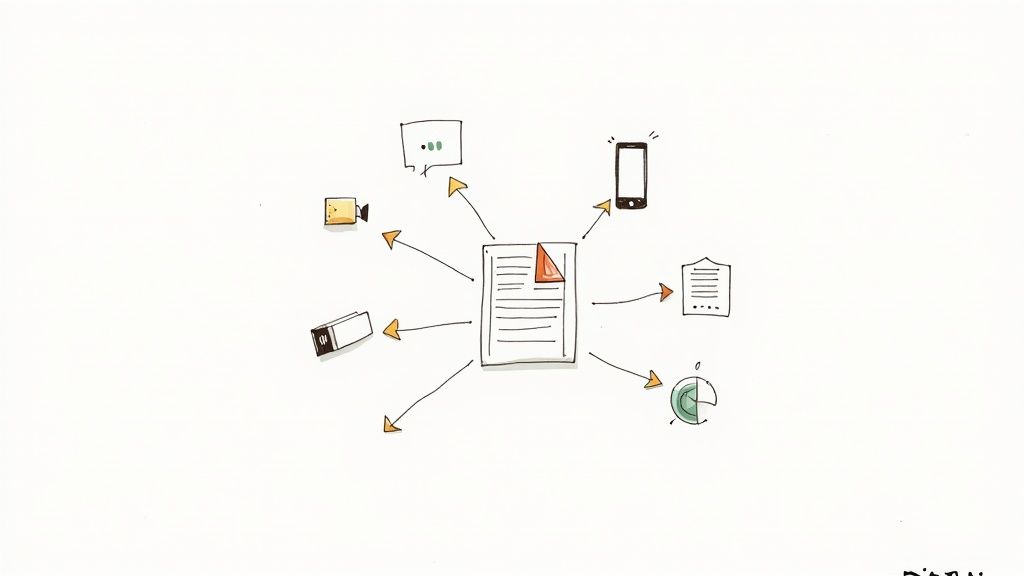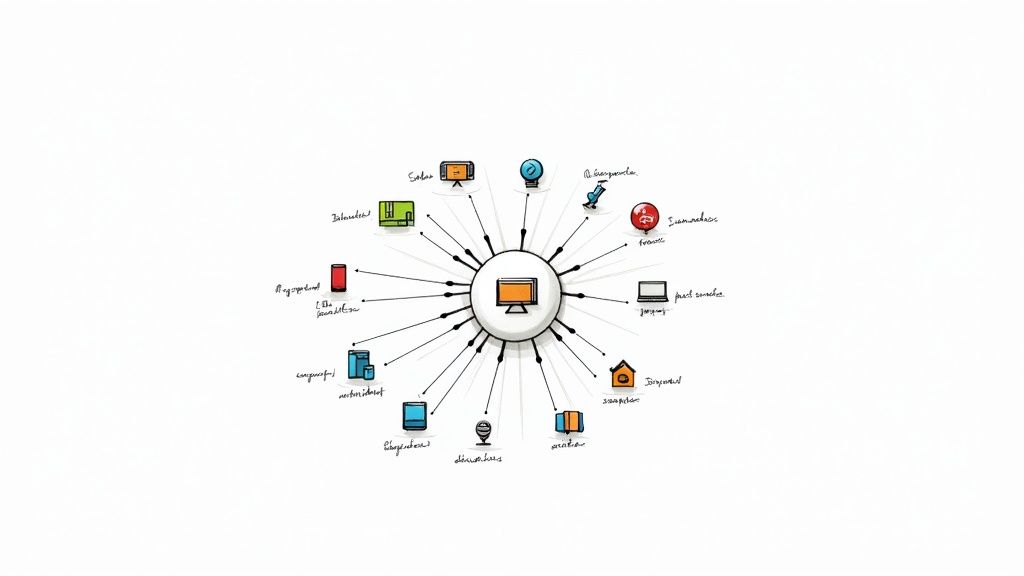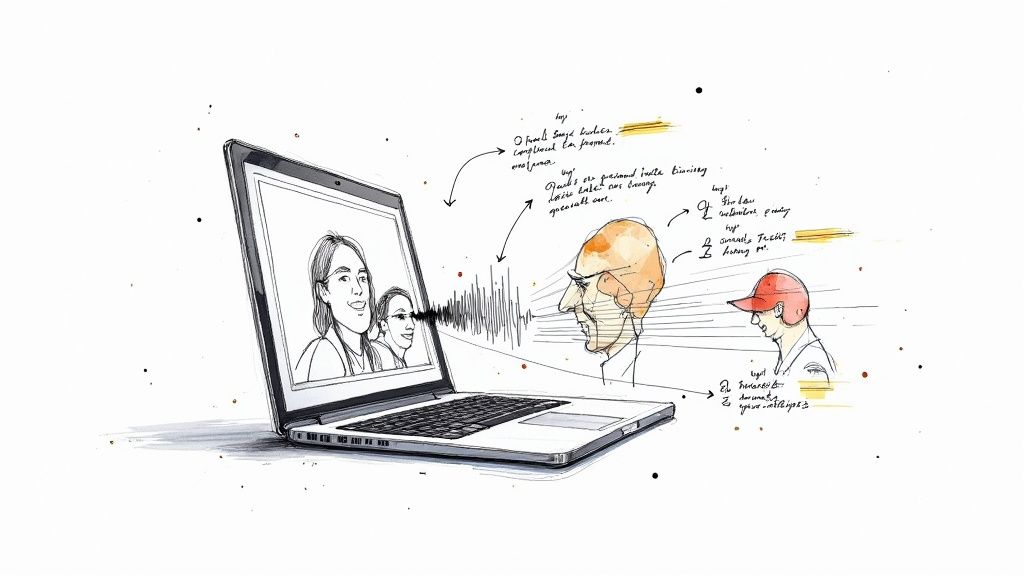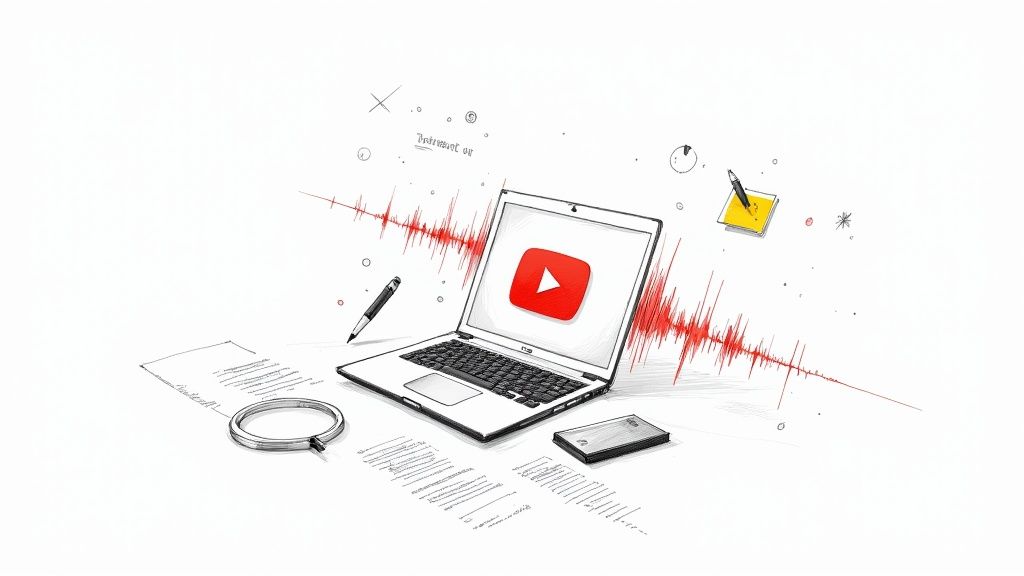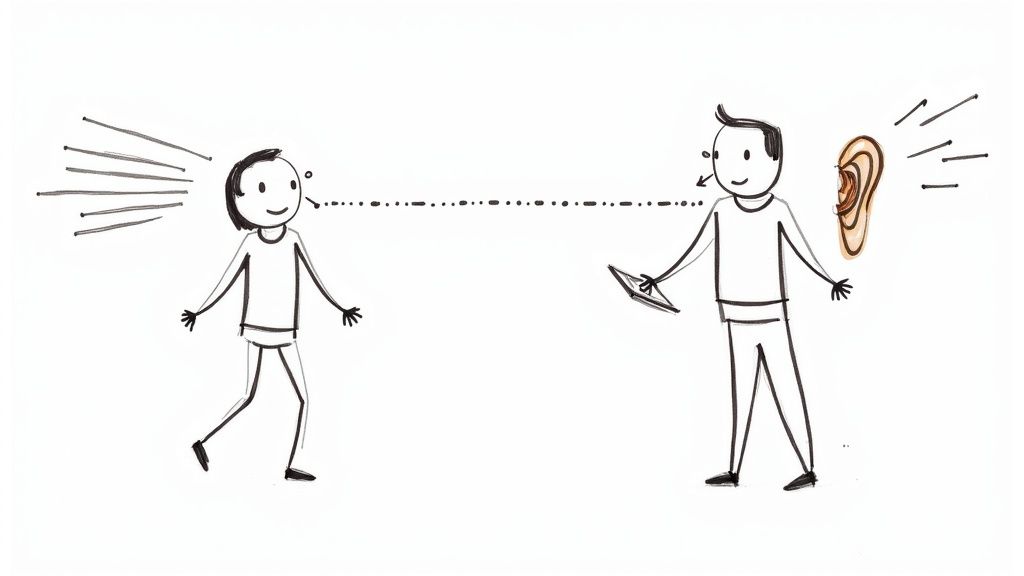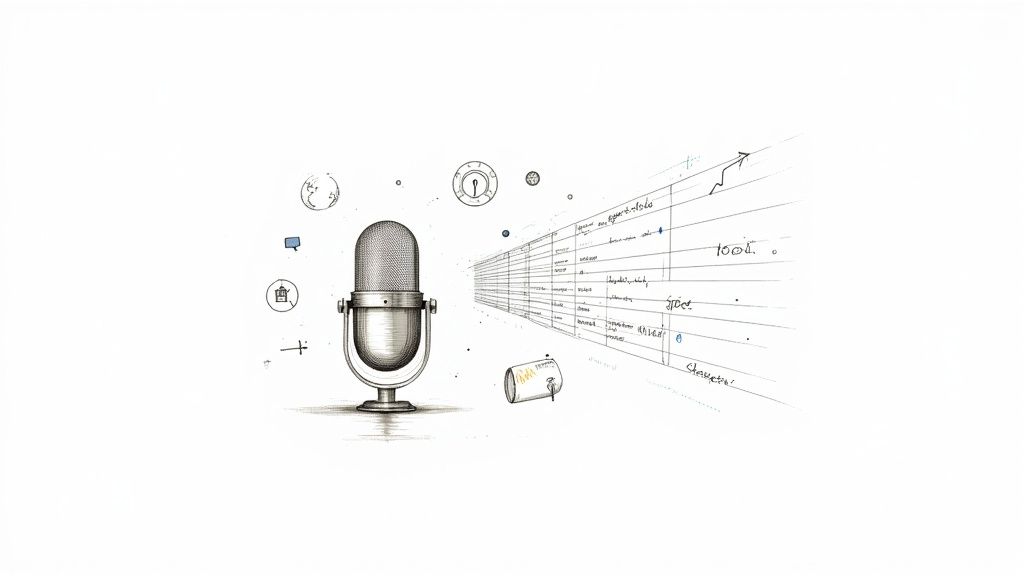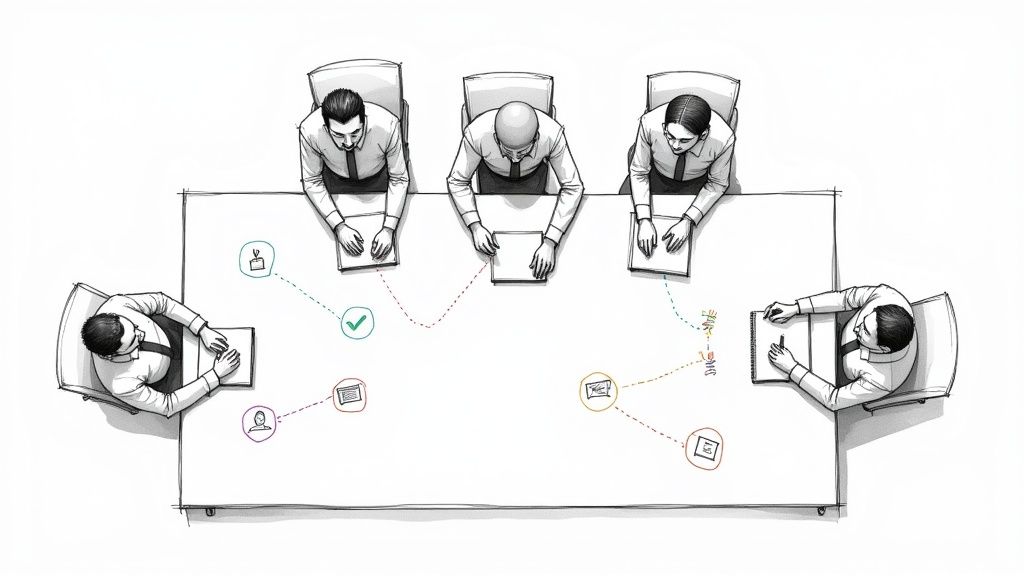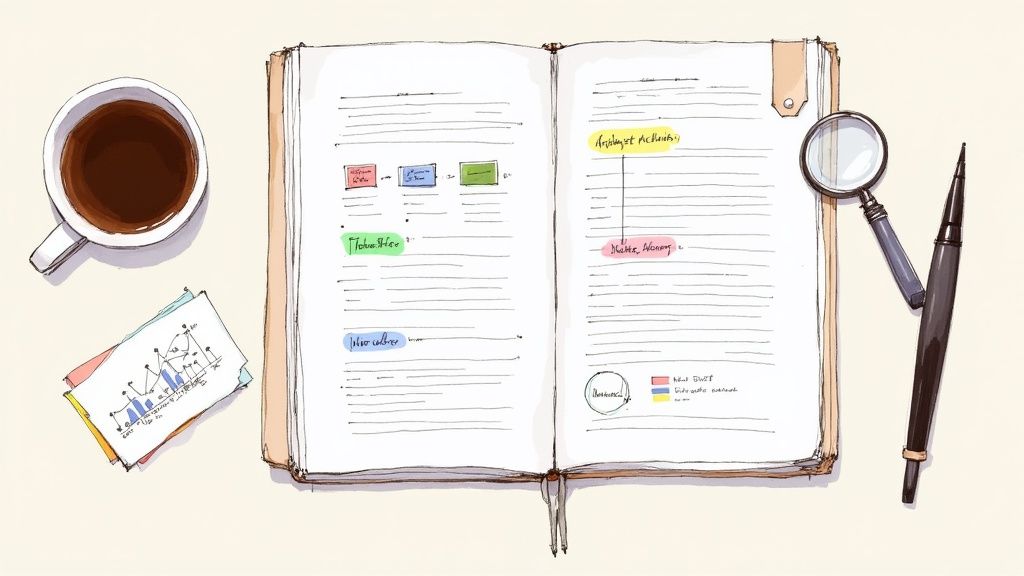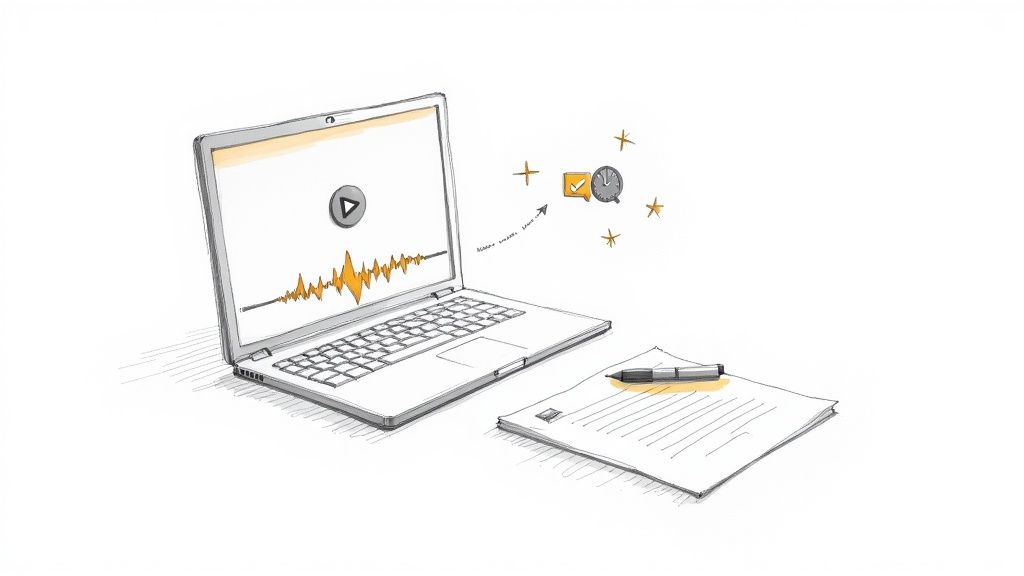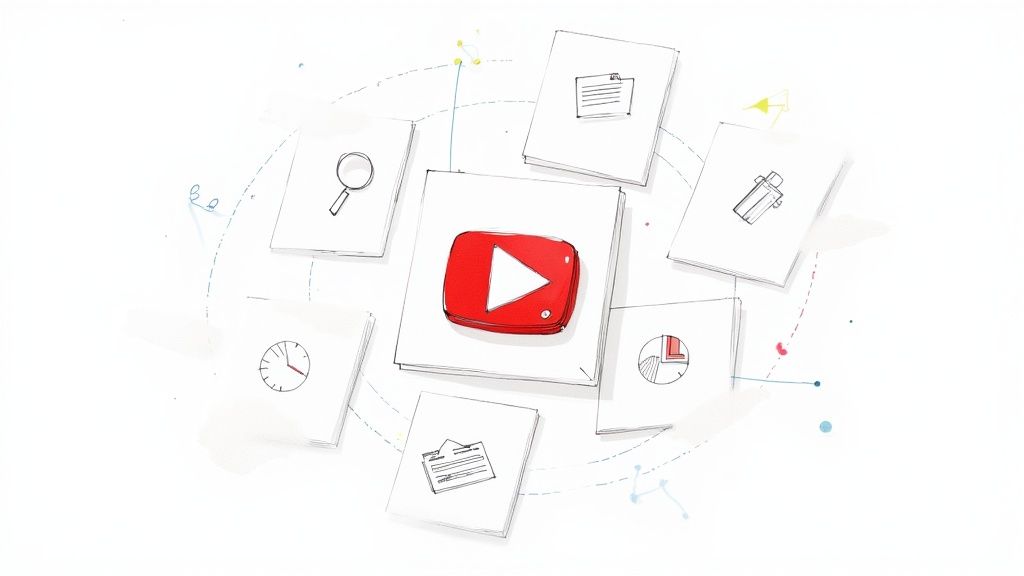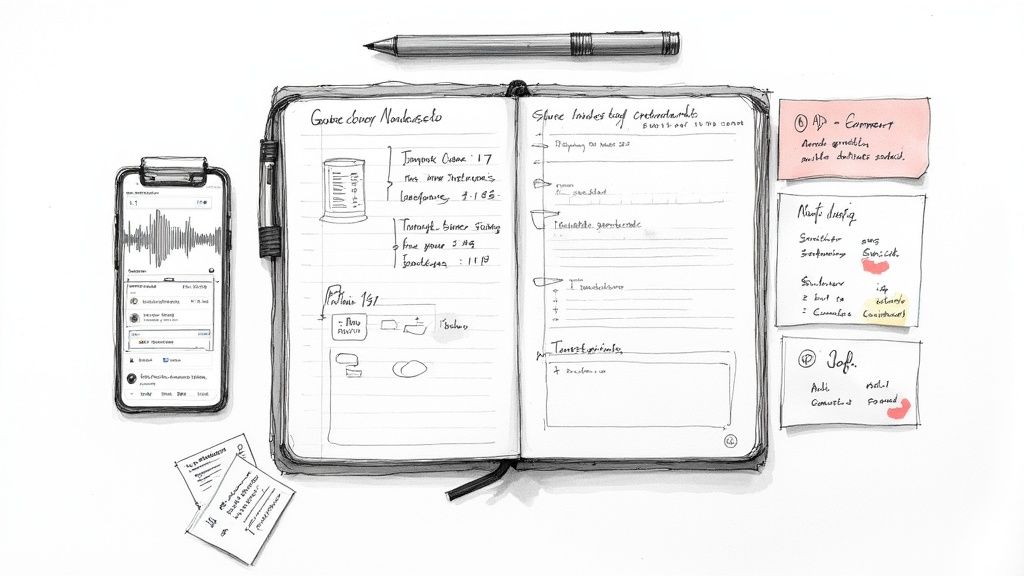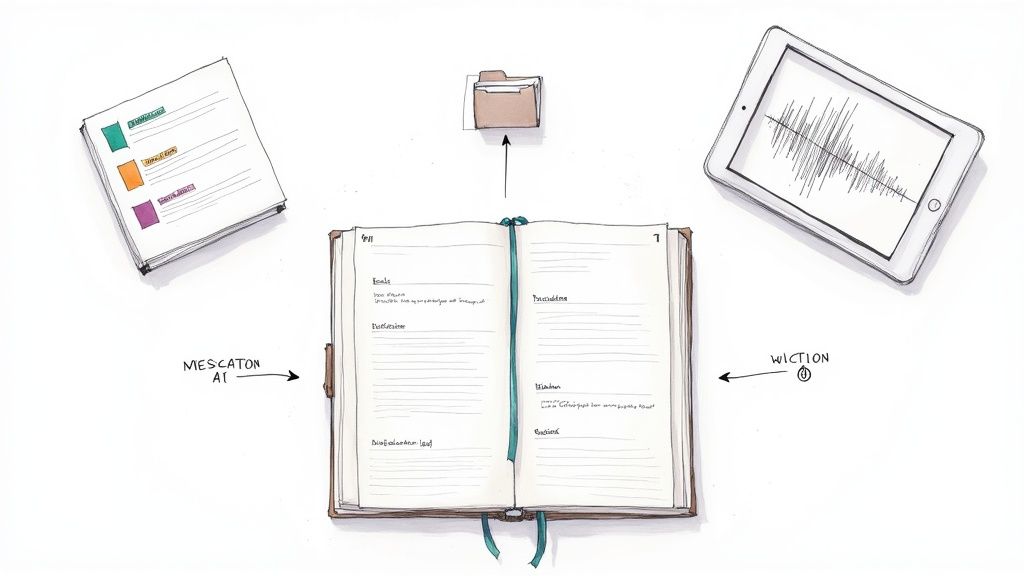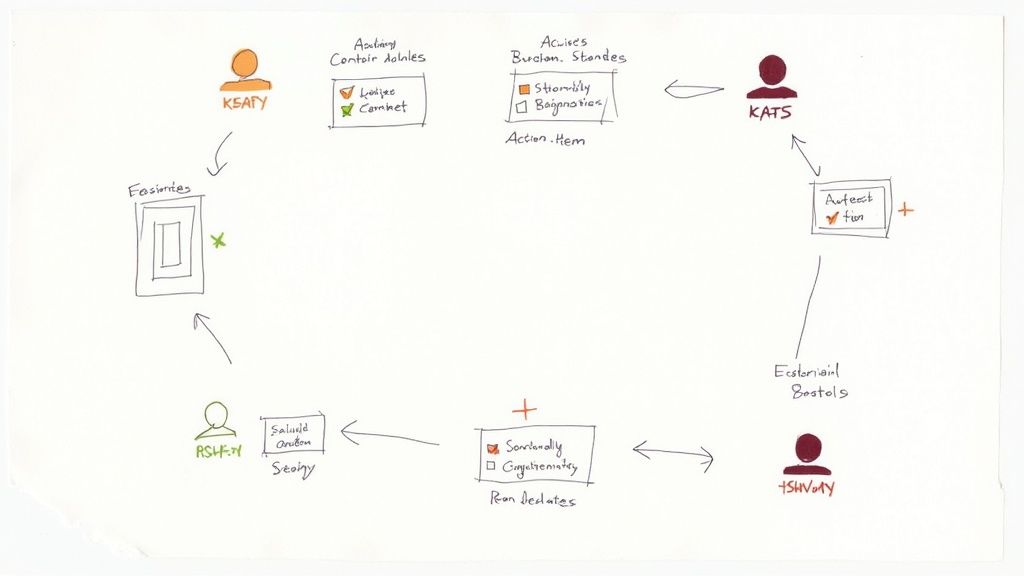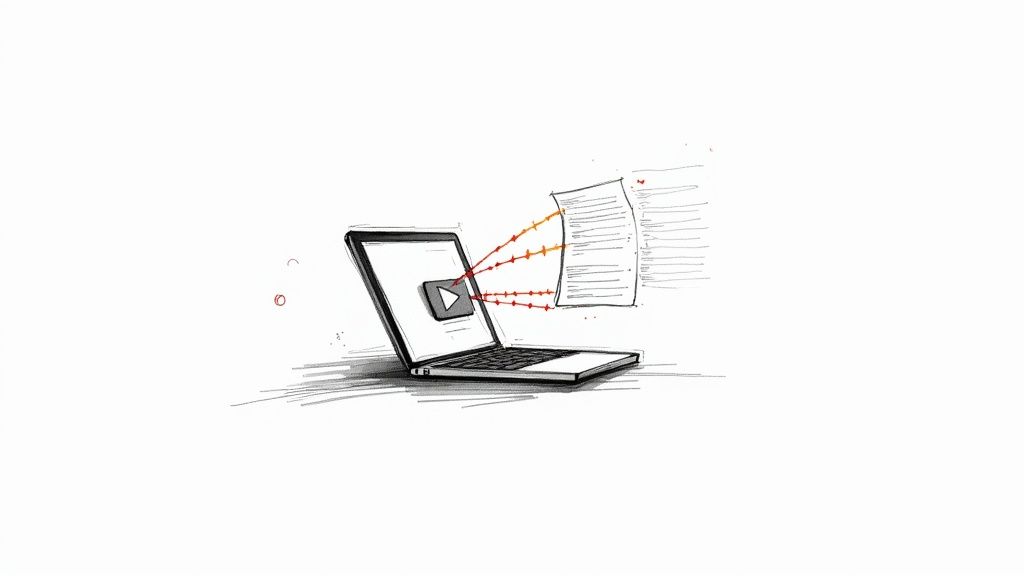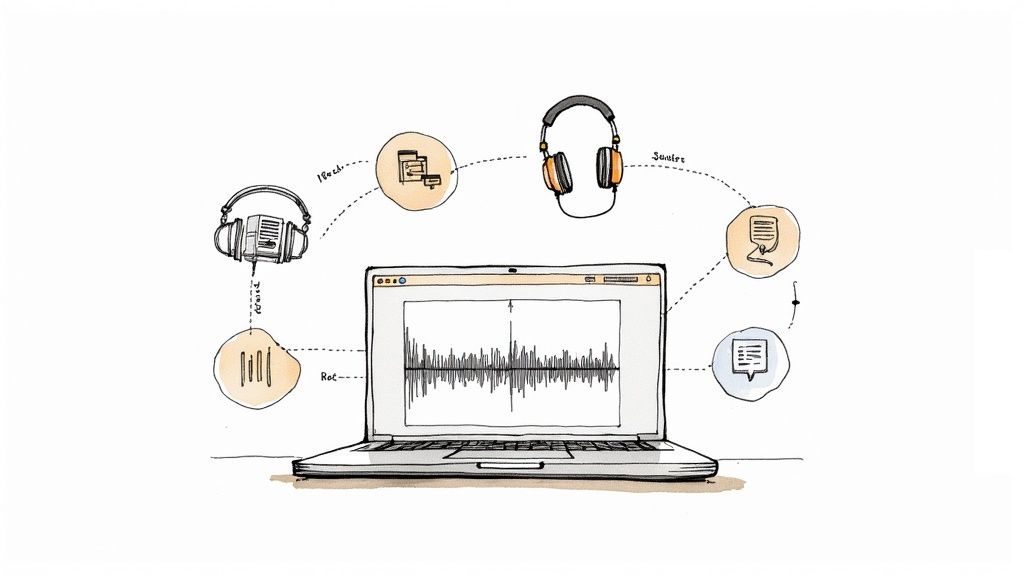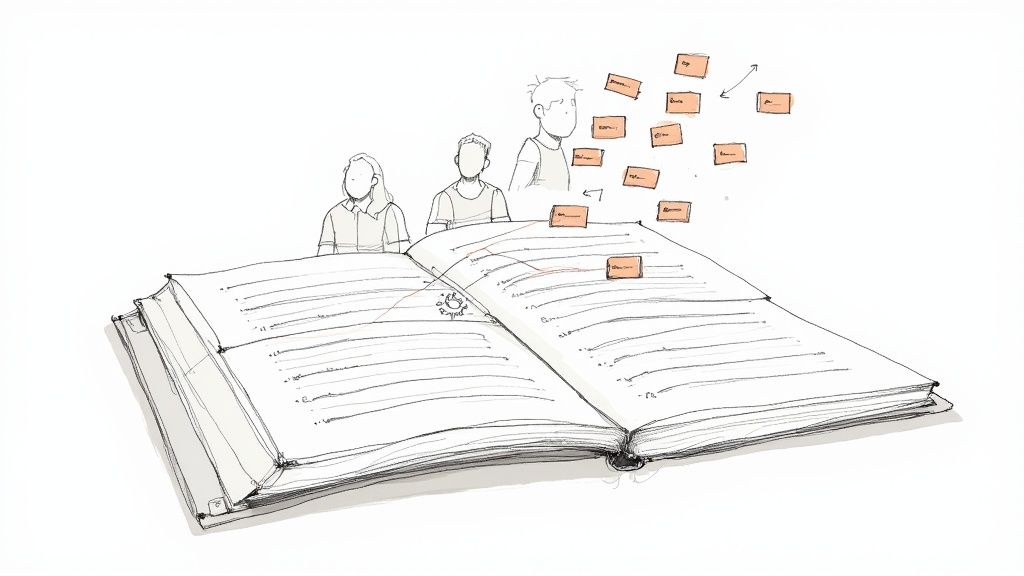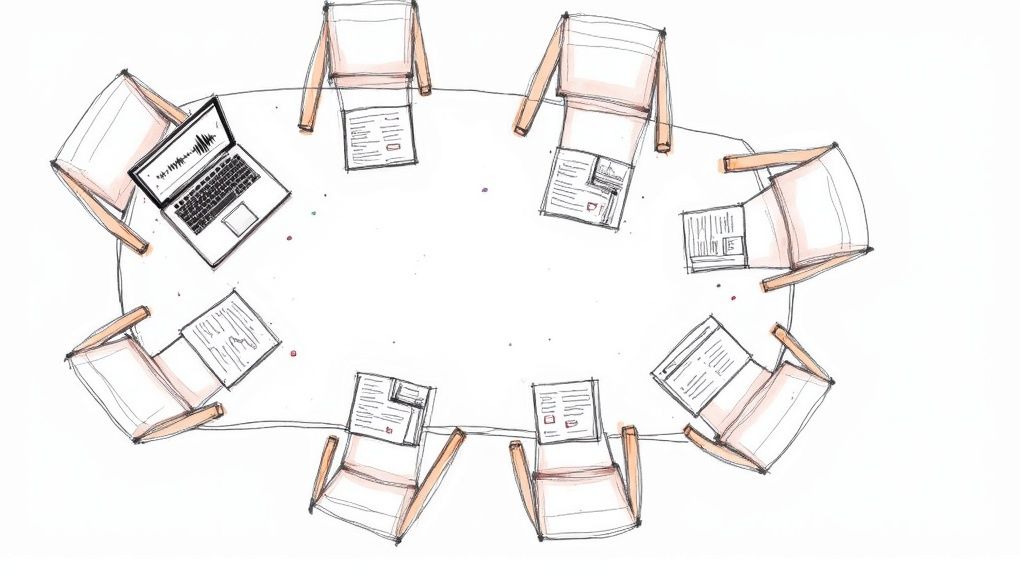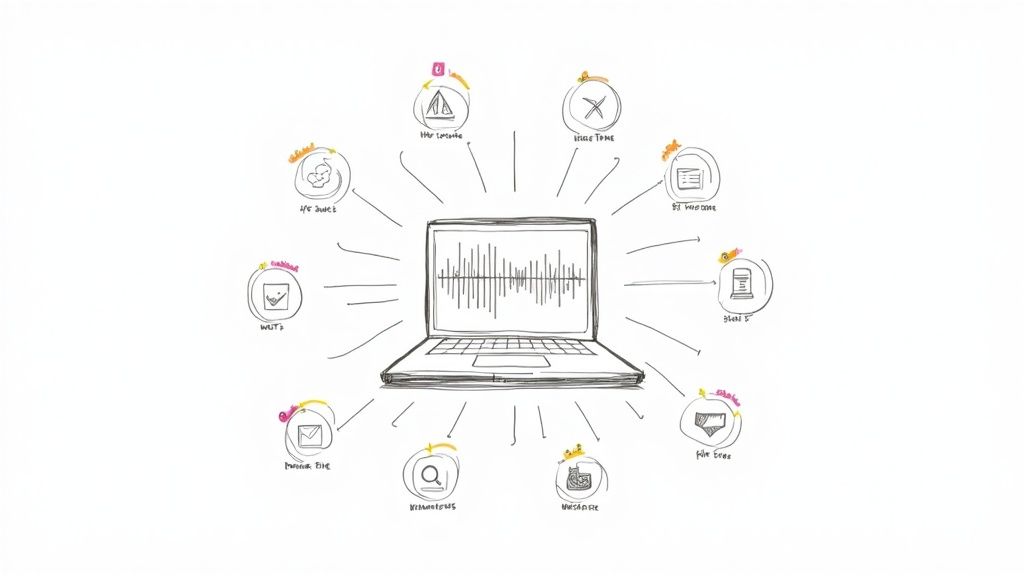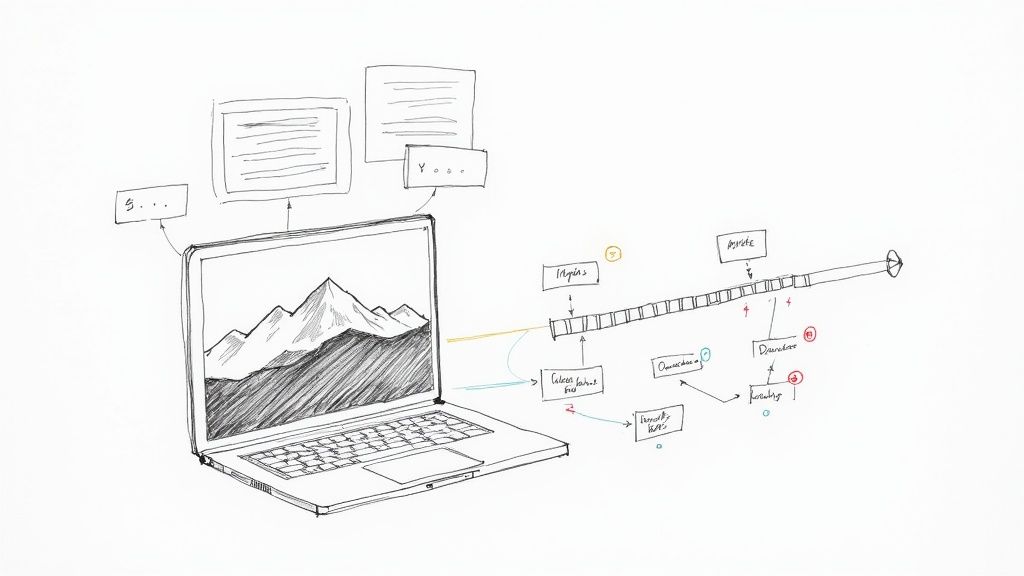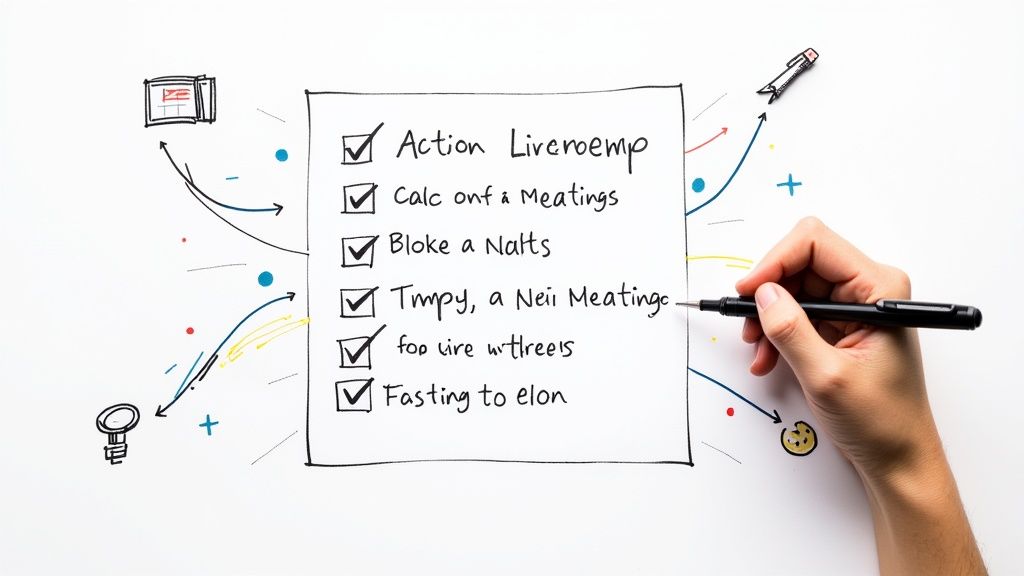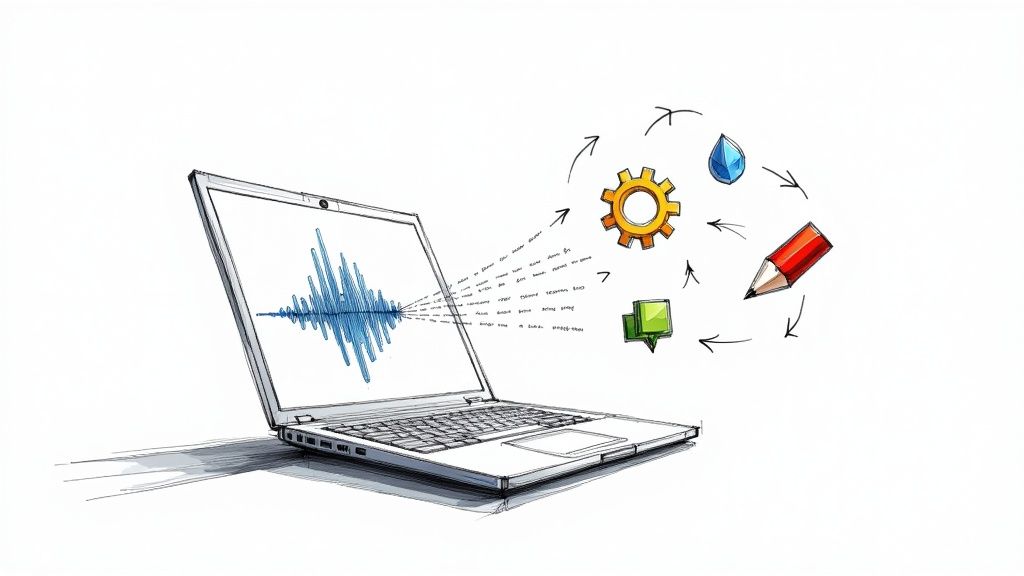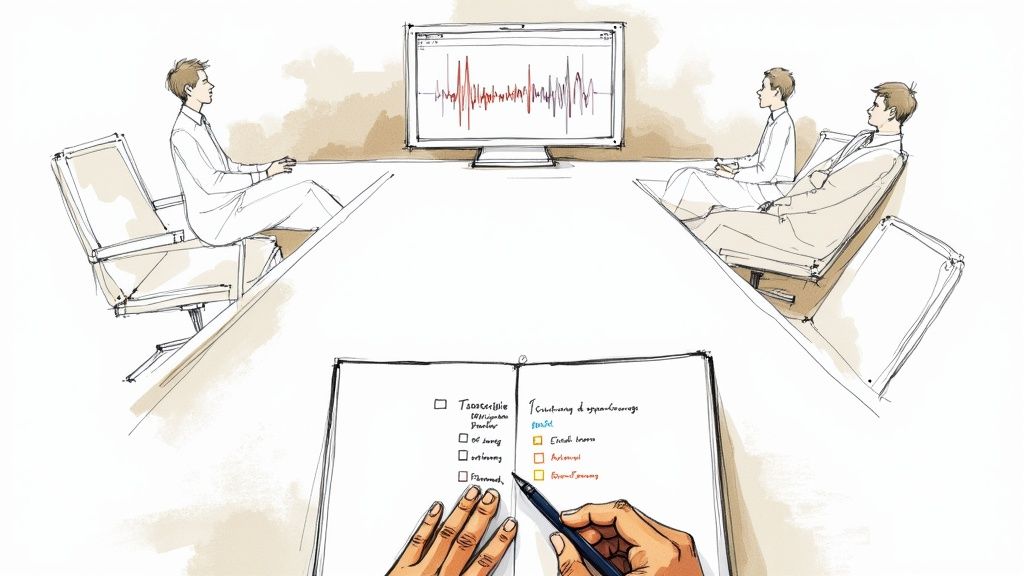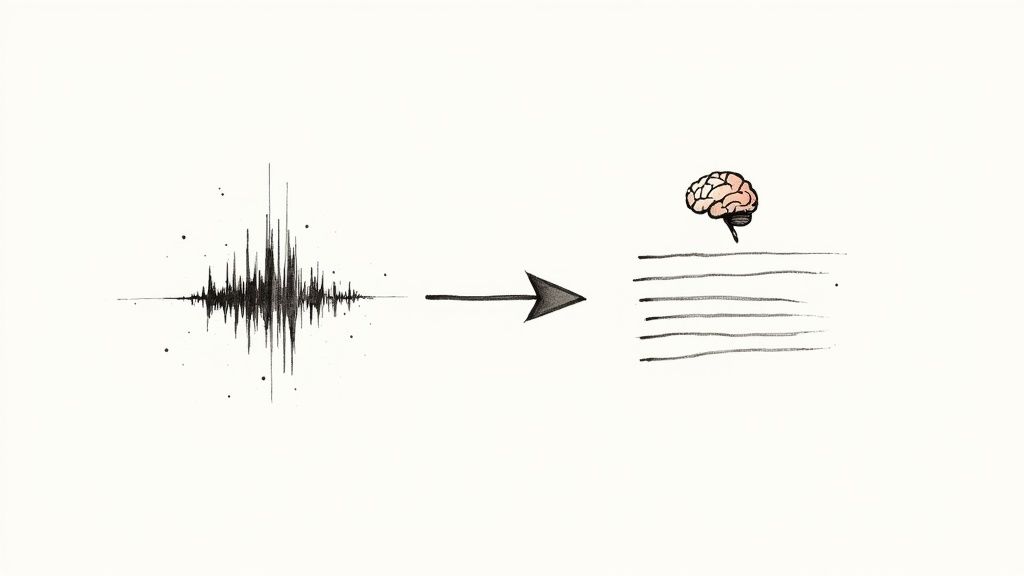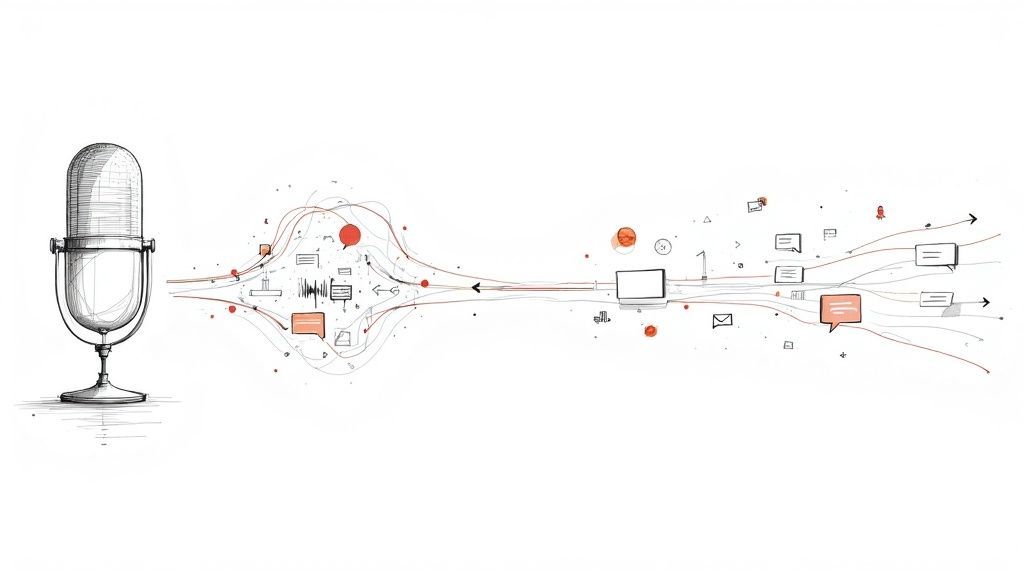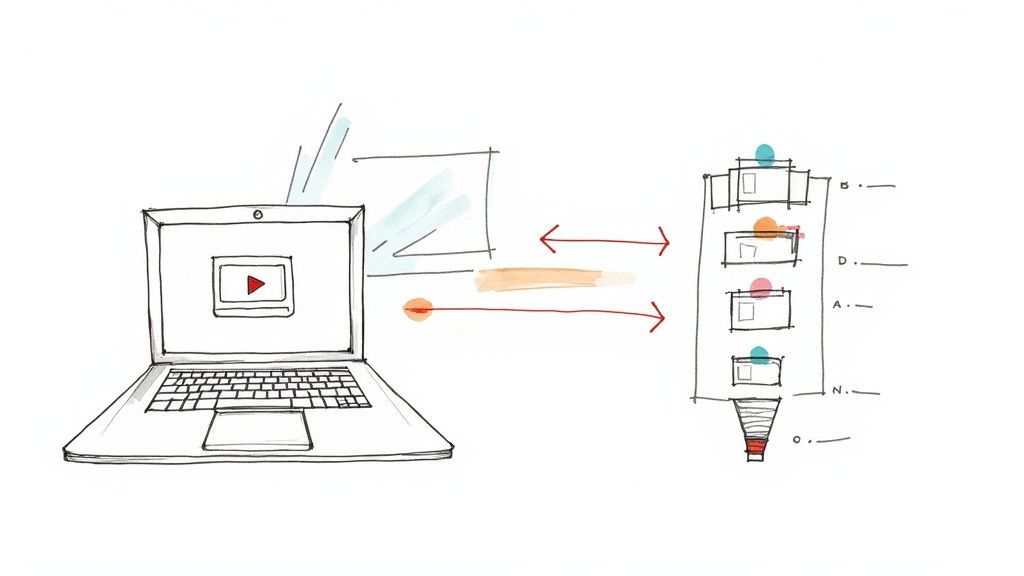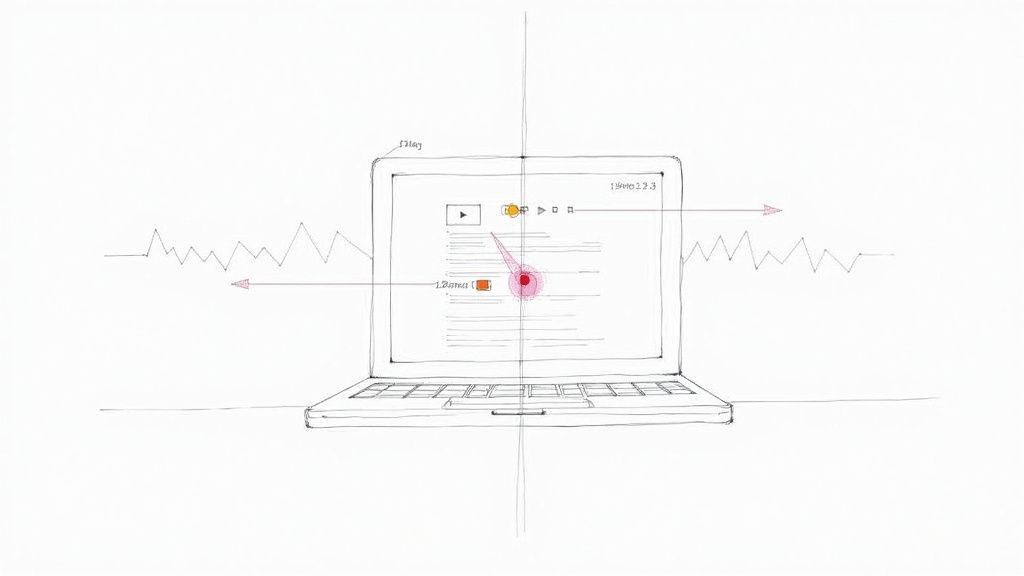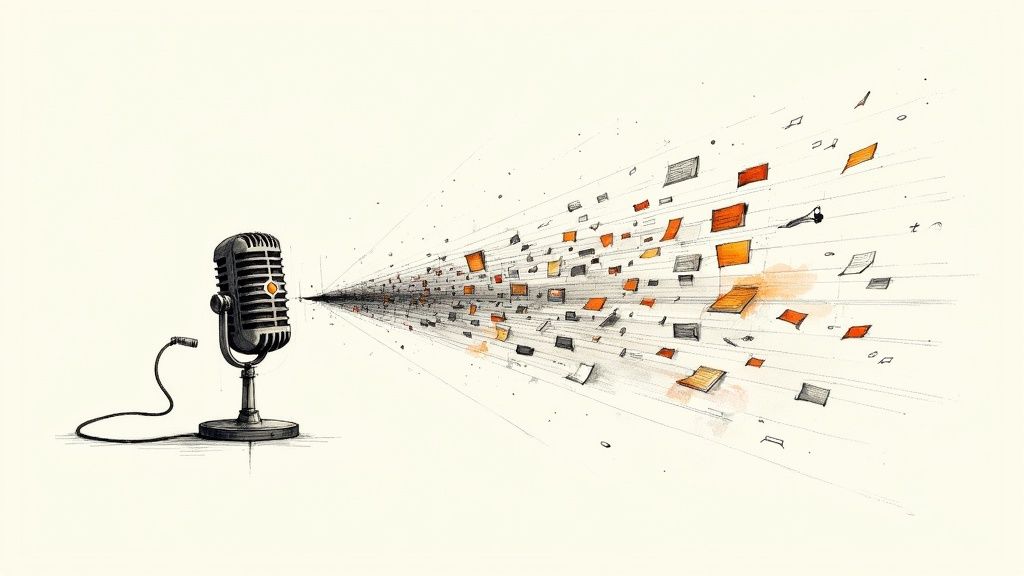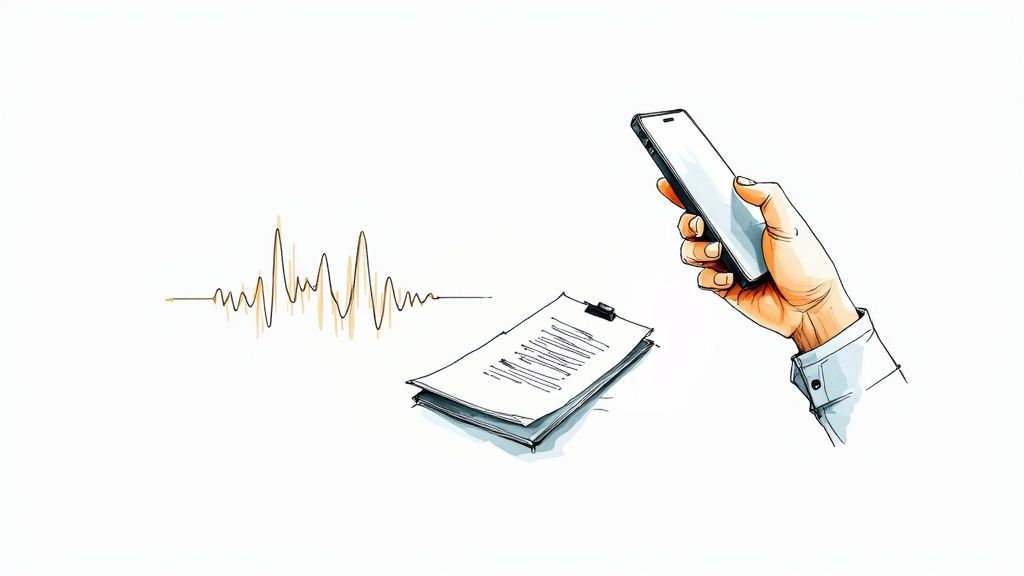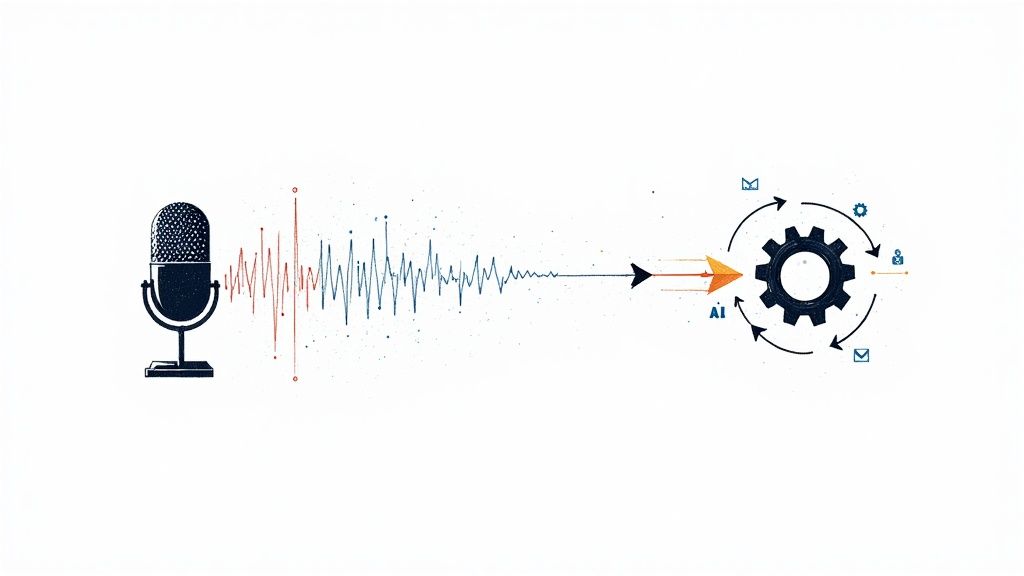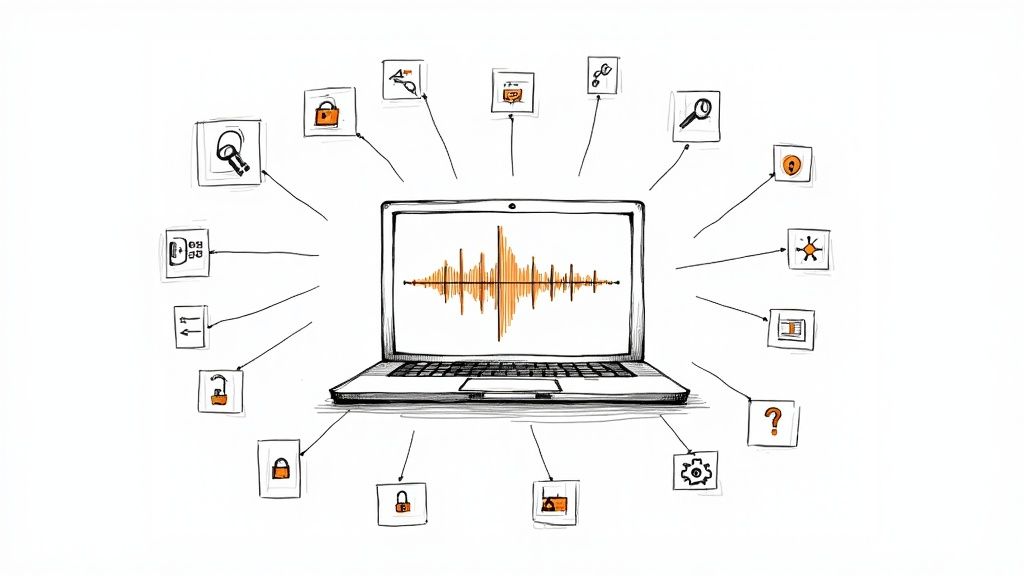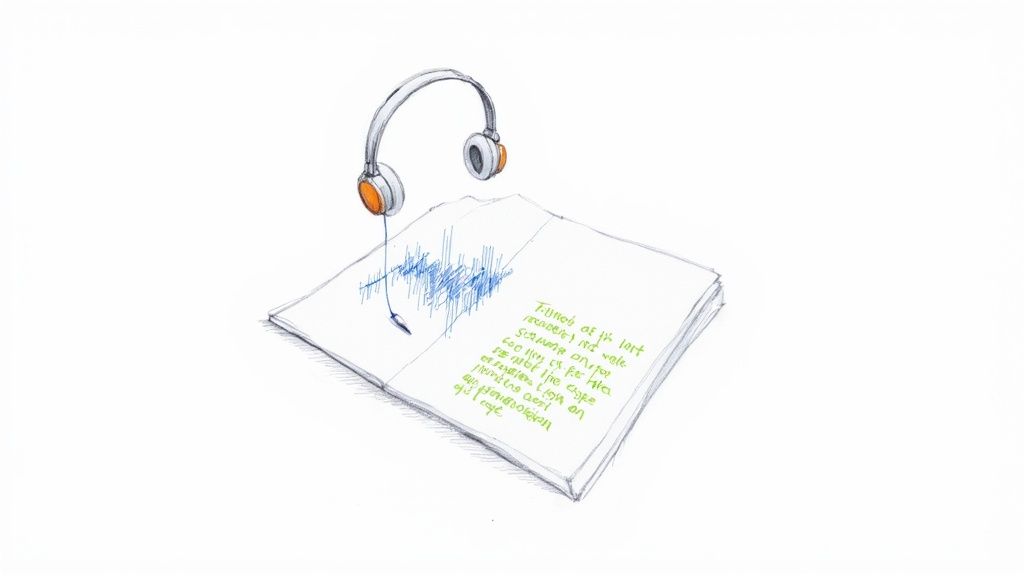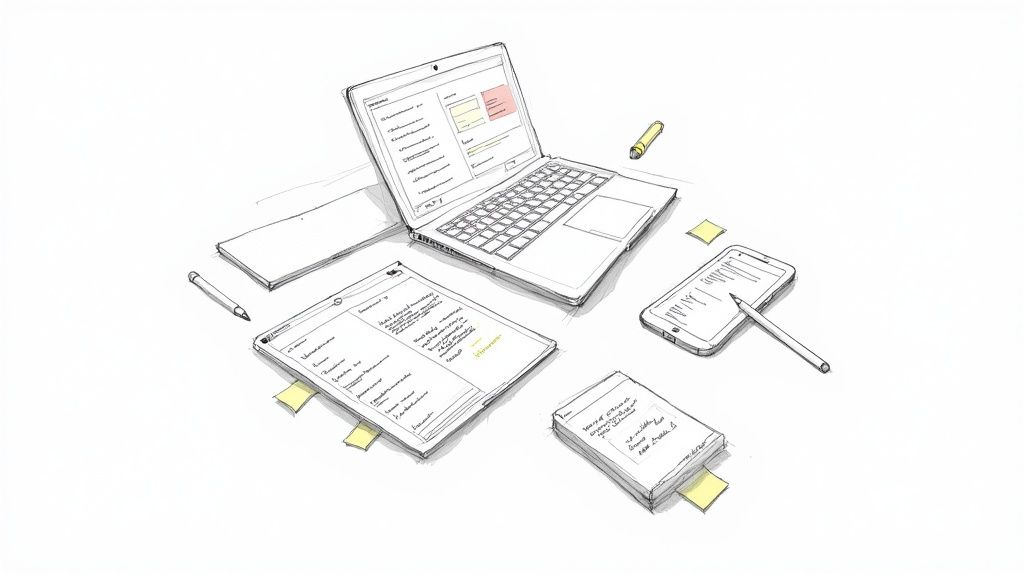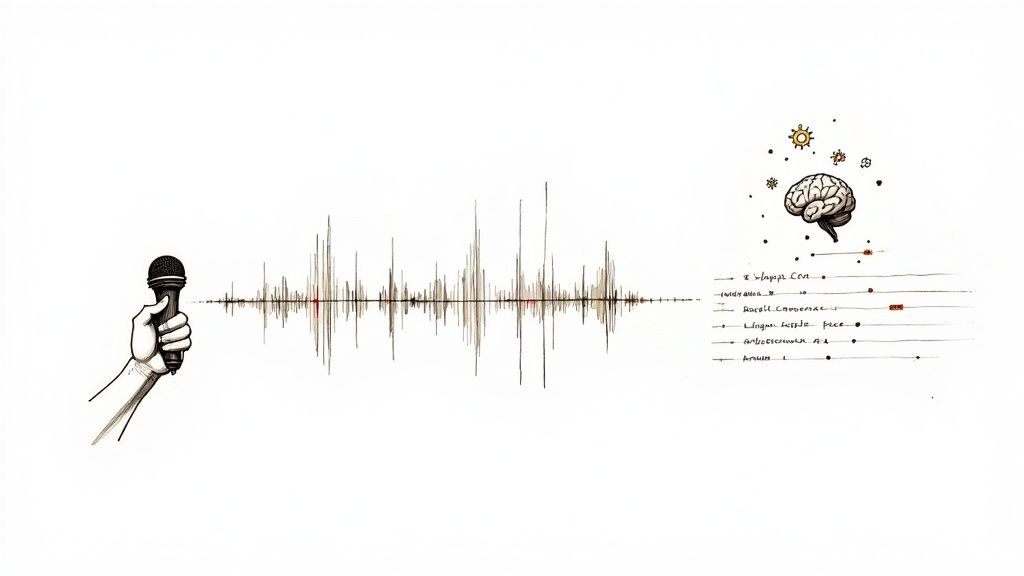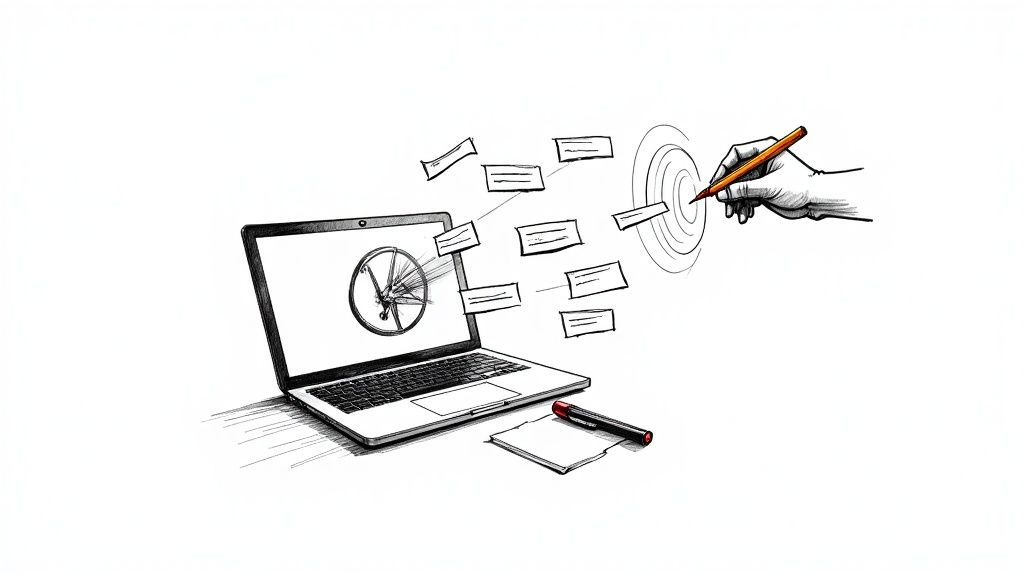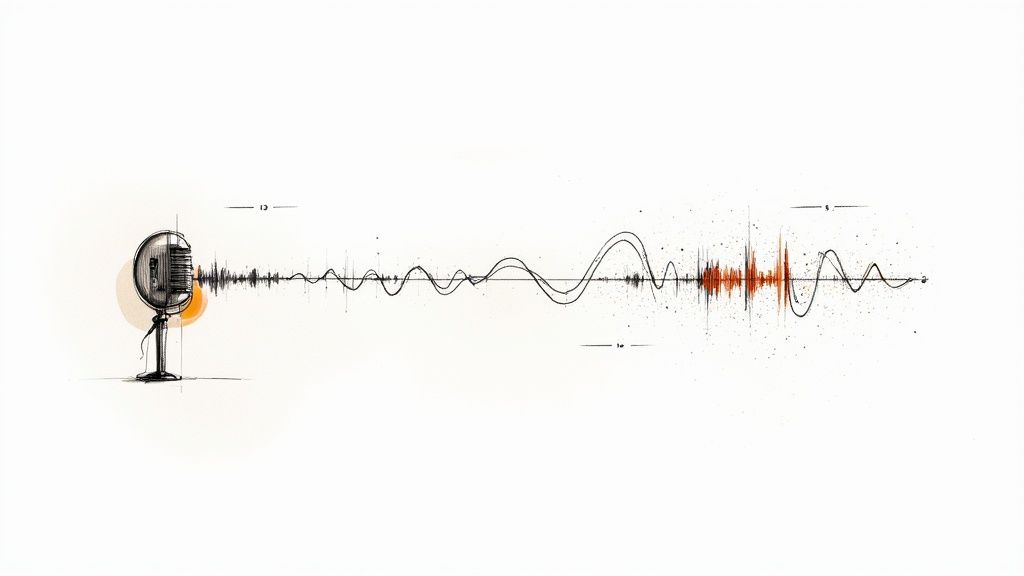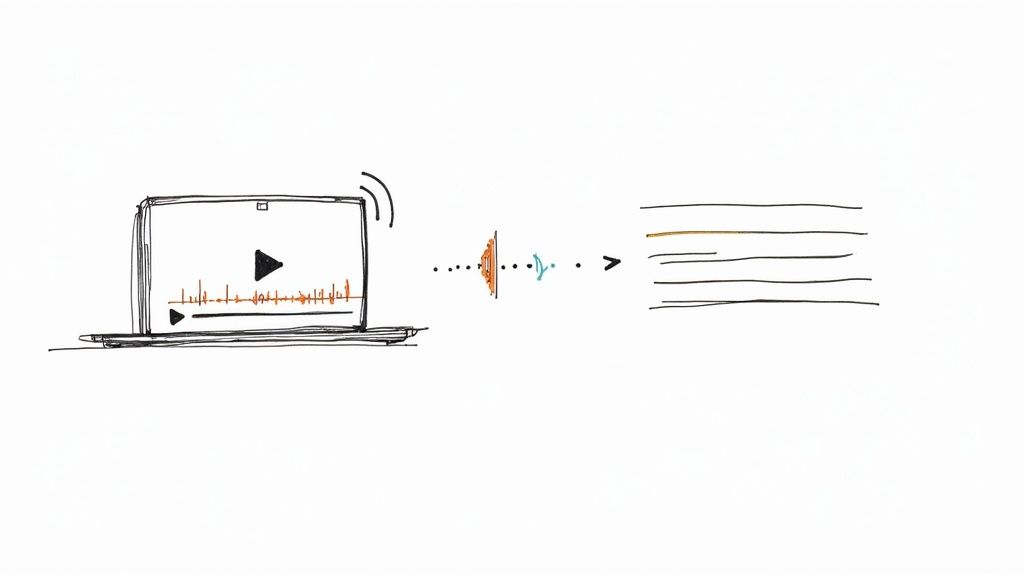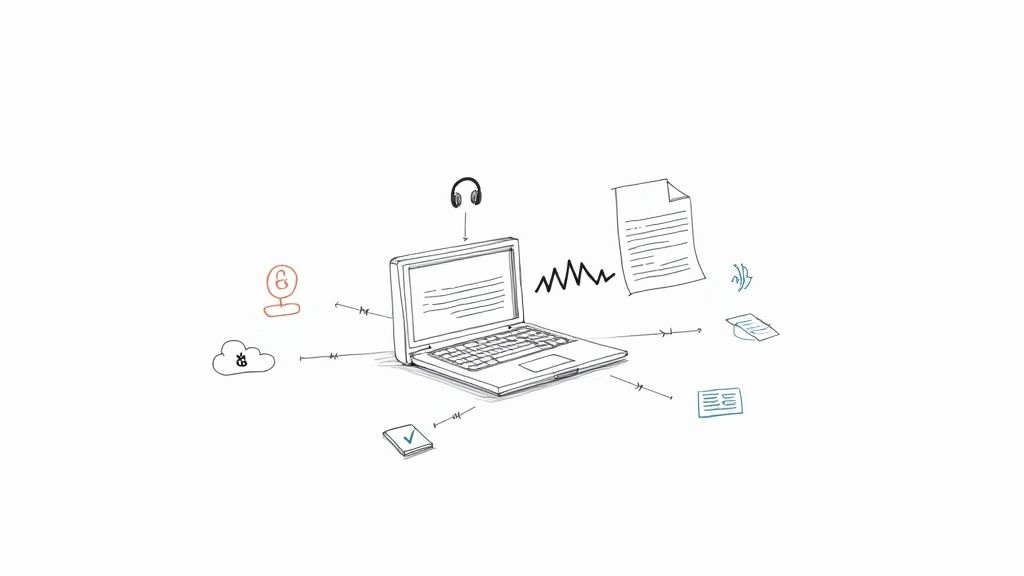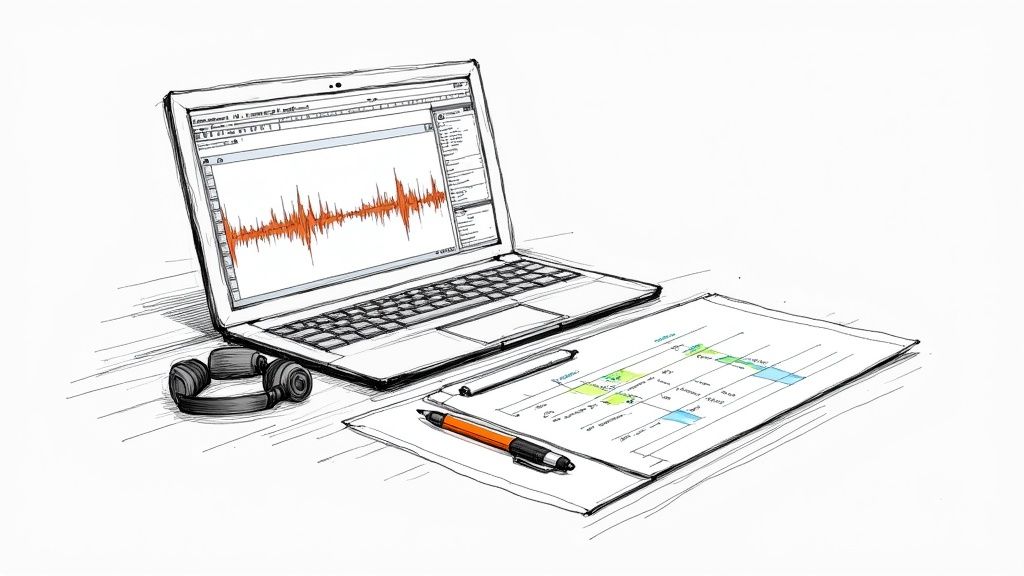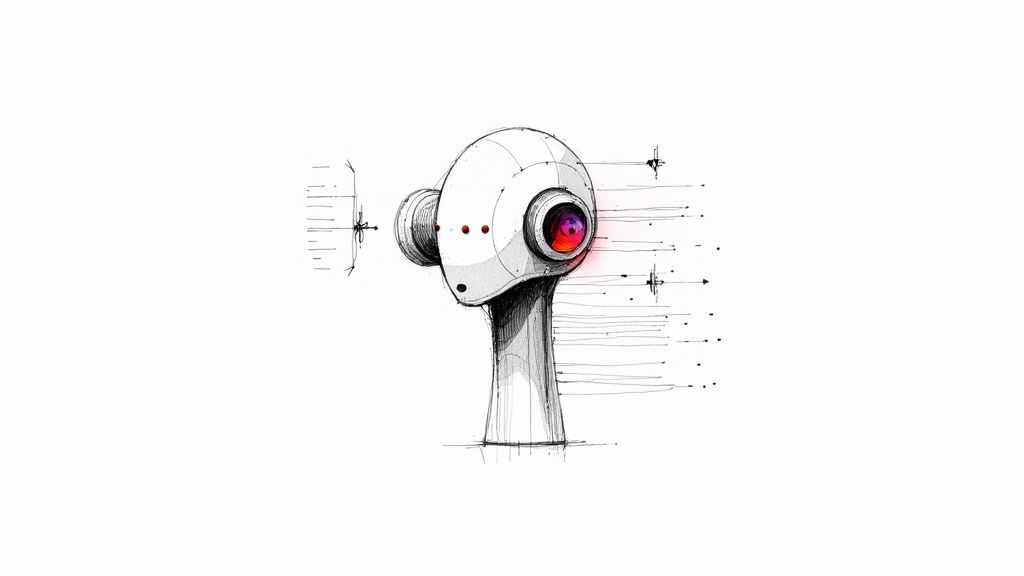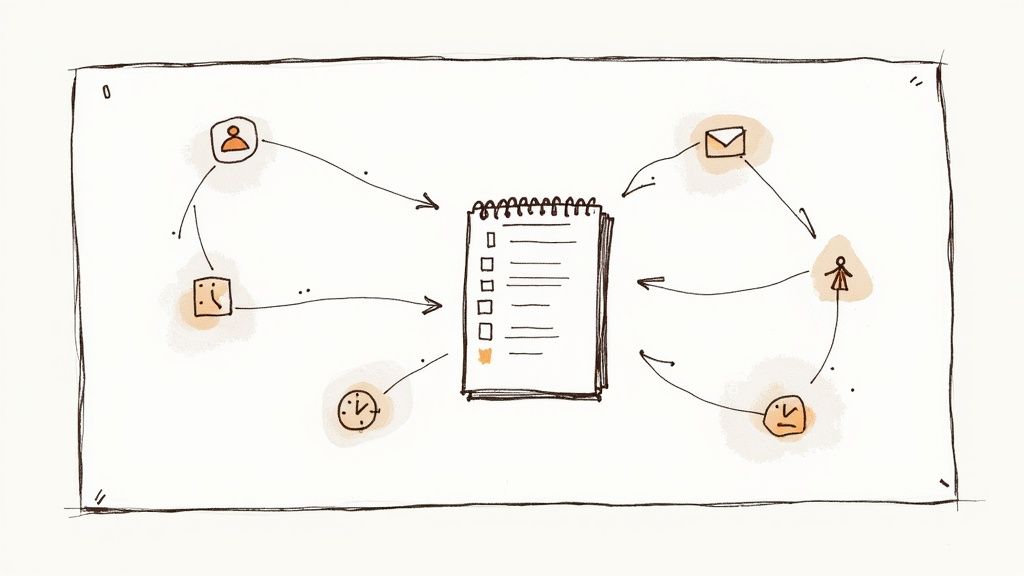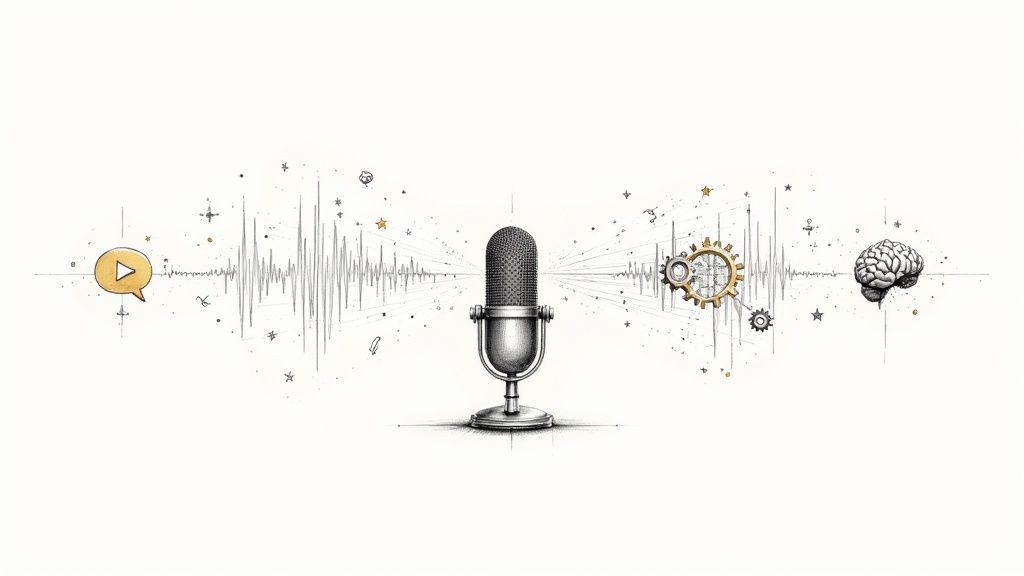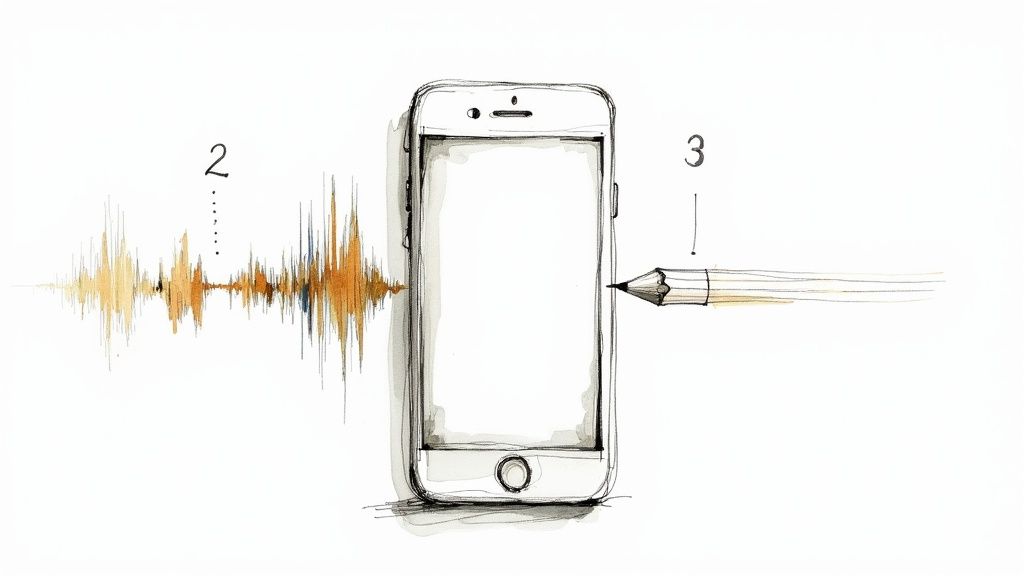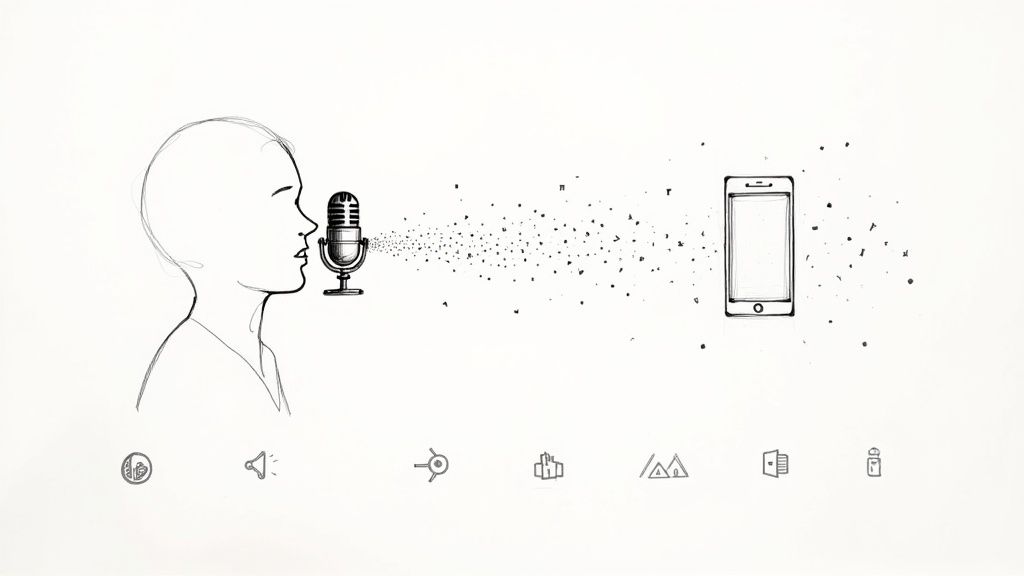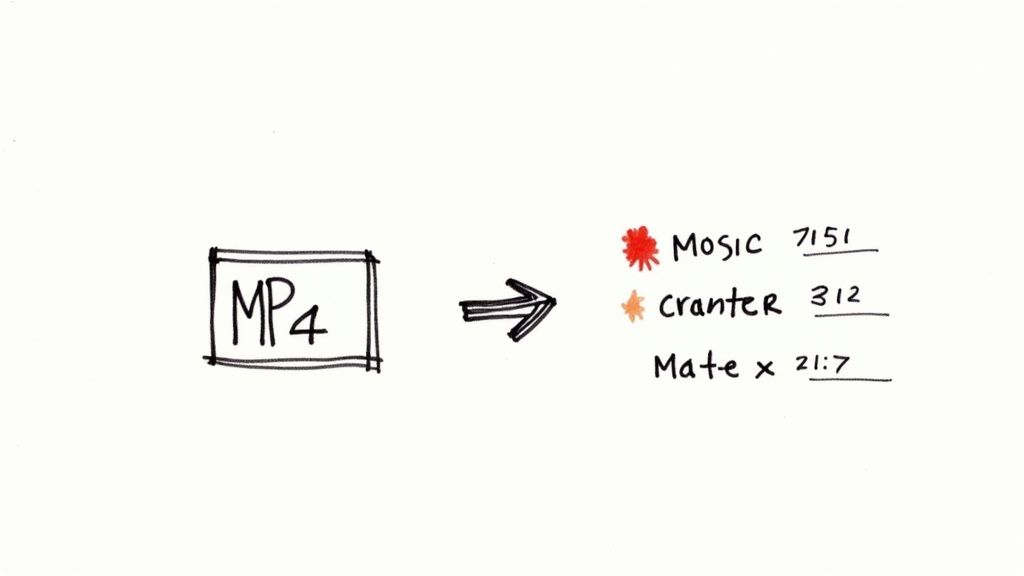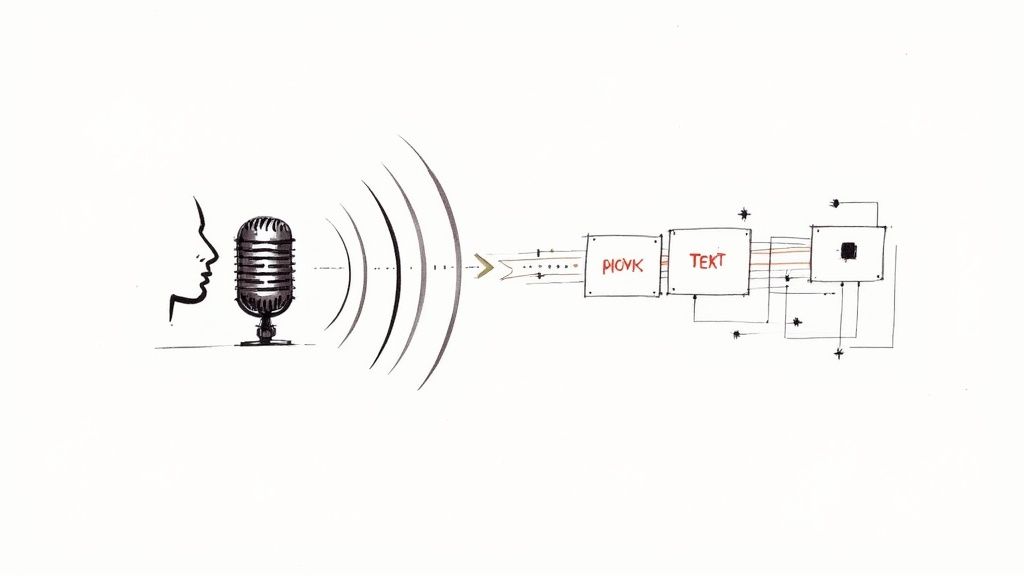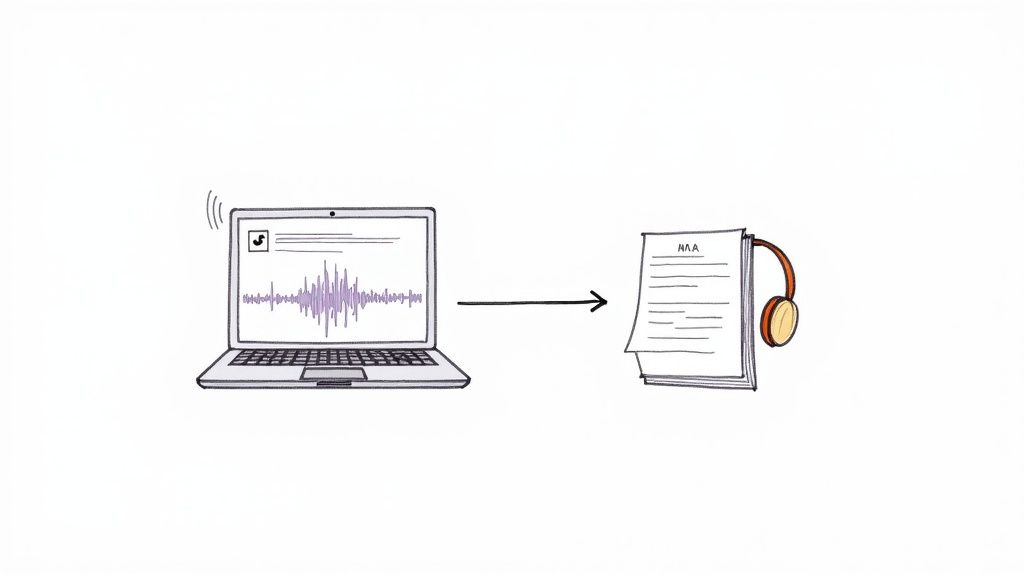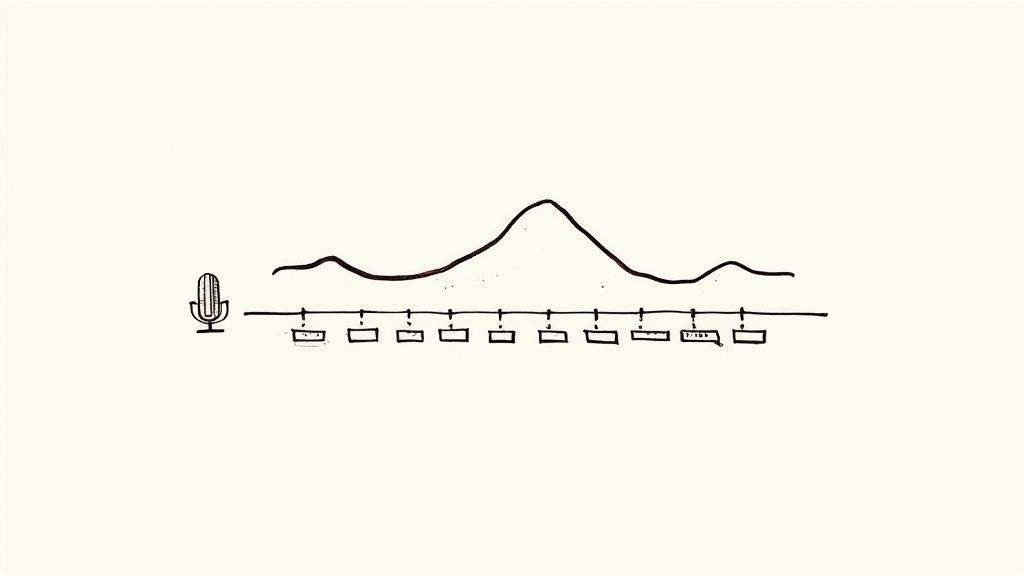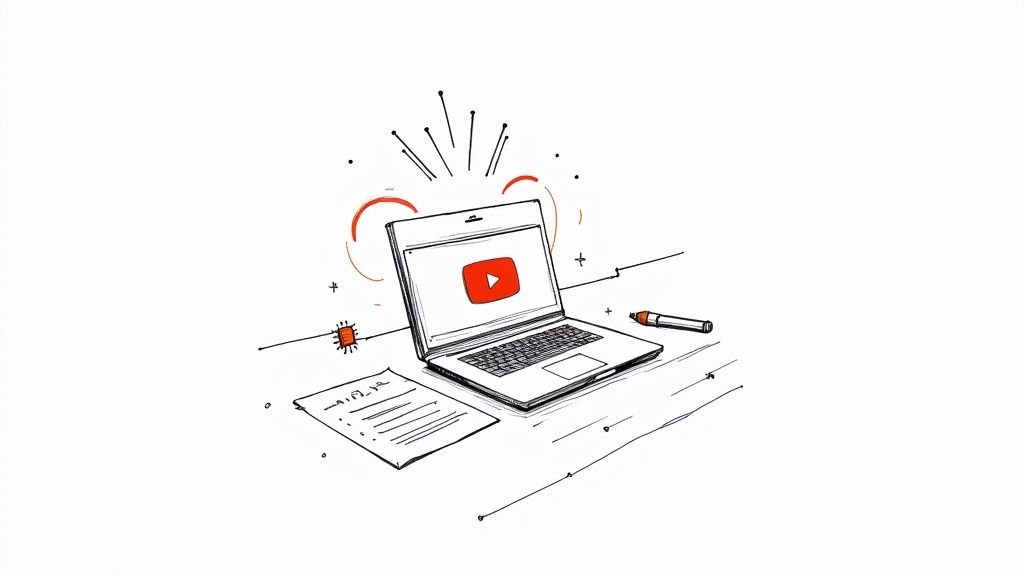
Unlocking Productivity with Speech to Text AI
Ever wished you had a personal assistant to type out everything you say? That's essentially what speech to text AI does. It's a technology that listens to spoken words and automatically turns them into written text, saving a massive amount of time on manual transcription.
This isn't just about convenience; it's about fundamentally changing how we interact with information. In this guide, we'll dive into how this technology works, from transcribing meeting minutes on the fly to making digital content accessible to everyone, and show you how to get the most out of it.
What Is Speech To Text AI And How Does It Work?
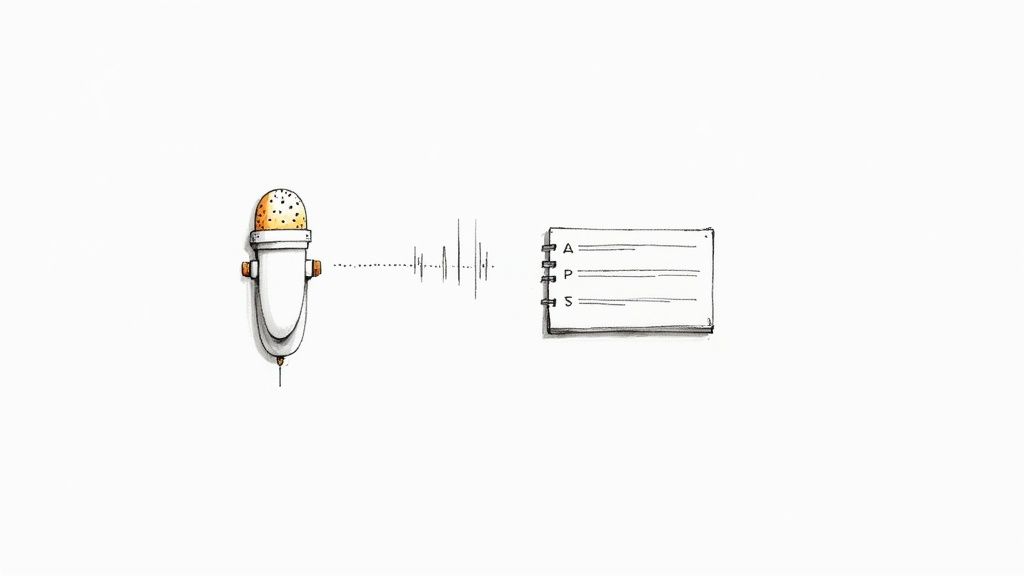
At its heart, speech to text AI—also known by its technical name, Automatic Speech Recognition (ASR)—is all about teaching computers to listen and understand like we do. It goes beyond just recording audio; these systems are trained to break down the soundwaves of human speech, pick out individual phonetic sounds, and stitch them back together into words and sentences that make sense.
It's a complex process that mirrors our own ability to listen, process, and comprehend what someone is saying.
Projected Market Growth for Speech To Text API
This isn't just a niche technology anymore. Speech to text AI is becoming a cornerstone of modern business, and the market numbers tell the story. The demand for fast, accurate, and automated transcription is exploding.
This incredible growth, from USD 3.8 billion to a projected USD 8.57 billion by 2030, is being fueled by everything from smarter mobile apps to businesses scrambling to automate their internal workflows. It's clear that turning voice into data is no longer a "nice-to-have"—it's a core operational need.
The Brains Behind The Operation
So, what makes it all tick? The magic is powered by artificial intelligence, particularly the machine learning models at its core. If you want to get into the nitty-gritty, understanding the foundational concepts of AI is a great place to start.
These AI models are trained on absolutely massive datasets—we're talking thousands upon thousands of hours of audio from countless speakers. This extensive training process teaches the AI to recognize the subtle building blocks of human language, including:
- Phonemes: The smallest distinct sounds in a language, like the 'p' in "pet" or the 'sh' in "shoe."
- Accents and Dialects: The system learns to parse the huge variety in how people from different places pronounce the same words.
- Contextual Cues: It figures out that "write" and "right" sound the same but mean different things based on the surrounding words in a sentence.
By analyzing this vast ocean of spoken data, the AI develops an almost intuitive grasp of language. It learns to predict the most probable word sequences, which is why it can often produce accurate text even when the audio has background noise or the speaker mumbles. This predictive ability is the key difference between modern ASR and the clunky, old-school voice command software of the past.
How AI Learns to Understand Your Voice
Ever wonder how your smart speaker catches your command from across the room? It’s not magic, but it’s close. It’s all down to training a speech to text AI to listen and process language in a way that’s surprisingly similar to how we do it.
The whole process hinges on two key parts working in perfect sync.
The Acoustic Model: The AI's Ear
First up is the Acoustic Model. You can think of this as the system’s ear. Its one and only job is to listen to the raw audio of your voice and chop it up into the smallest units of sound—what linguists call phonemes.
For instance, it has to learn the subtle difference between the "c" sound in "cat" and the "h" sound in "hat." To get good at this, the model is fed thousands of hours of audio recordings, featuring all sorts of accents, pitches, and background noises.
The Language Model: The AI's Brain
Once the acoustic model has its string of sounds, it hands them over to the Language Model. If the acoustic model is the ear, this is the brain. It takes that jumble of sounds and figures out the most probable sequence of words.
It’s not just guessing, though. This model has been trained to understand grammar, context, and the common ways words fit together. It knows "ice cream" is a far more likely phrase than "eyes cream," which helps it make smart decisions when a sound is a bit fuzzy.
The Power of Training Data
The secret sauce here is data—massive amounts of it. By analyzing enormous text datasets, the language model learns the statistical patterns of a language. It’s this deep understanding of how words relate to each other that allows it to turn a stream of phonemes into coherent sentences.
This is what makes modern speech to text AI so incredibly effective. The system is constantly learning from new audio and text, getting better and better at understanding how we speak. It’s a cycle of continuous improvement.
This field is absolutely exploding. Speech and voice recognition currently make up an $8.49 billion slice of the AI market, and experts predict it will soar to over $23 billion by 2030. This incredible growth is all thanks to better and more sophisticated AI training. You can dig deeper into these trends in a report from MarketsandMarkets.
From Sound Wave to Written Word: The Transcription Process
Ever wondered what actually happens when you speak into your phone and text magically appears? It’s a sophisticated process that turns the vibrations of your voice into clean, readable text. Let's walk through how a speech to text AI pulls this off, step by step.
It all starts the moment you say something. The sound waves from your voice are captured by a microphone and instantly converted into a digital audio signal. But this raw signal is often messy, full of background chatter, echoes, or fluctuating volume.
This infographic gives a great high-level view of the journey, showing how the AI moves from analyzing the basic sounds (the acoustic model) to understanding the context of the words (the language model).
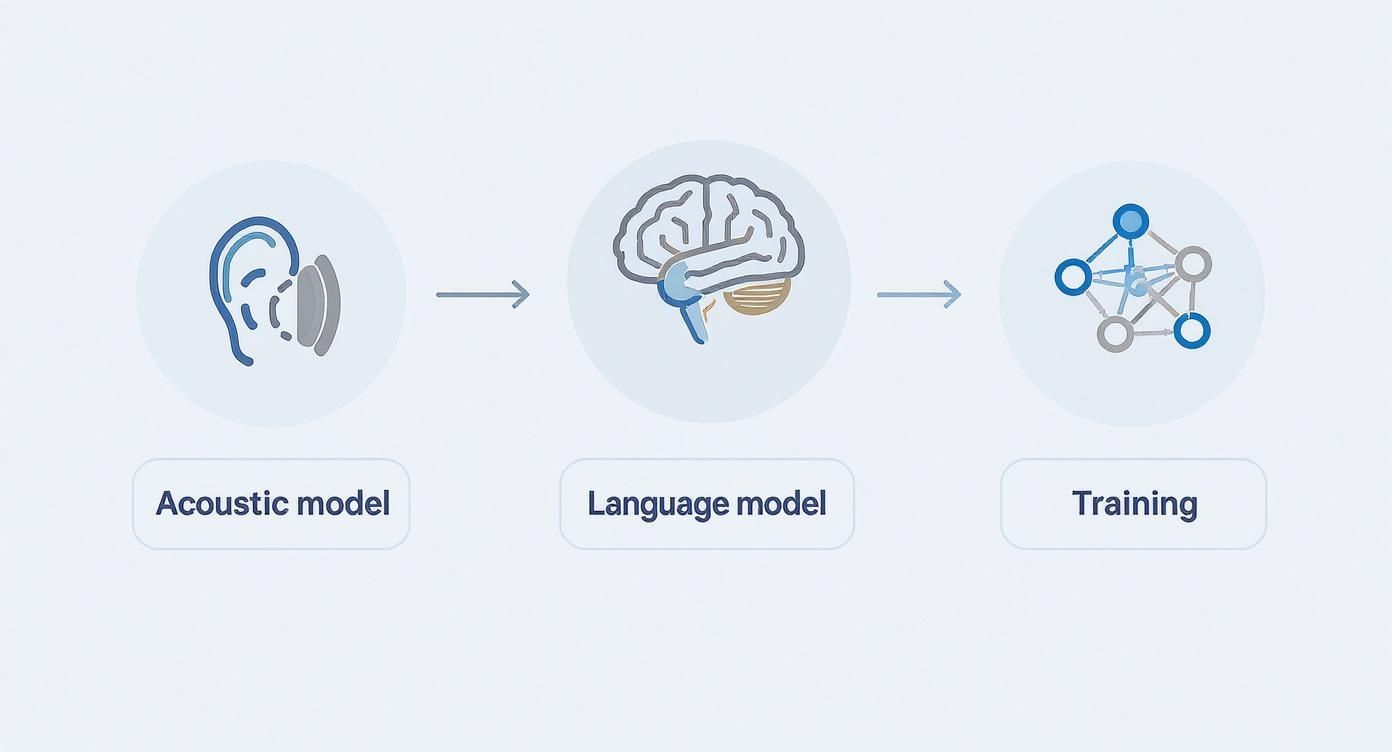
As you can see, it’s not a single flip of a switch. It’s a chain of highly specialized tasks working together to get the final transcription right.
Step 1: Initial Cleanup and Analysis
The first job for the AI is to act like a sound engineer. This is the audio pre-processing stage, where algorithms get to work cleaning up the signal. They filter out background noise, even out the volume levels, and chop the audio into smaller, bite-sized pieces that are easier to analyze. Think of it as creating a clean workspace before starting the real work.
With a cleaner signal in hand, the acoustic model takes center stage. Its job is to break down the audio into its most fundamental building blocks: phonemes. These are the smallest units of sound that distinguish one word from another. For instance, the word "ship" is deconstructed into three phonemes: /sh/, /i/, and /p/.
Step 2: Decoding Sounds into Words
This is where the real intelligence kicks in. The language model receives the string of phonemes from the acoustic model and starts figuring out the most likely words they form. This is all about probability and context.
The language model knows from its training on massive amounts of text that "let's eat, grandma" is a far more common and logical phrase than "let's eat grandma." It's this contextual understanding that prevents embarrassing—and sometimes horrifying—mistakes.
The AI essentially runs through countless possibilities, creating a ranked list of potential word combinations and assigning a probability score to each one. The sequence with the highest score becomes the first draft of your transcript.
This whole journey, from the sound of your voice to a rough text draft, happens in the blink of an eye. It’s the system's incredible speed at weighing probabilities and applying contextual knowledge that makes modern speech-to-text AI so powerful compared to the clunky voice software of the past.
Step 3: Final Polish and Formatting
But it’s not done yet. The final step is post-processing, which adds the finishing touches. This is where punctuation is added, proper nouns are capitalized, and the text is formatted to be easy to read. More advanced systems can even distinguish between different speakers or automatically remove filler words like "um" and "ah," leaving you with a polished transcript.
Real-World Ways Speech to Text AI Boosts Efficiency
It’s easy to think of speech to text AI as just a simple conversion tool, but that’s only scratching the surface. In reality, it’s a powerful engine for efficiency that’s already changing how businesses operate across dozens of industries.
Its real magic lies in its ability to automate tasks that used to eat up hours of manual work. By taking transcription off our plates, it frees us up to focus on the things that actually require a human touch—like creative problem-solving and building relationships.
Imagine wrapping up a team meeting and having the full transcript, complete with action items, land in your inbox moments later. Or picture a live webinar with real-time captions, making it instantly accessible to a global, diverse audience. This isn't some far-off future; it's happening right now and delivering a serious return.
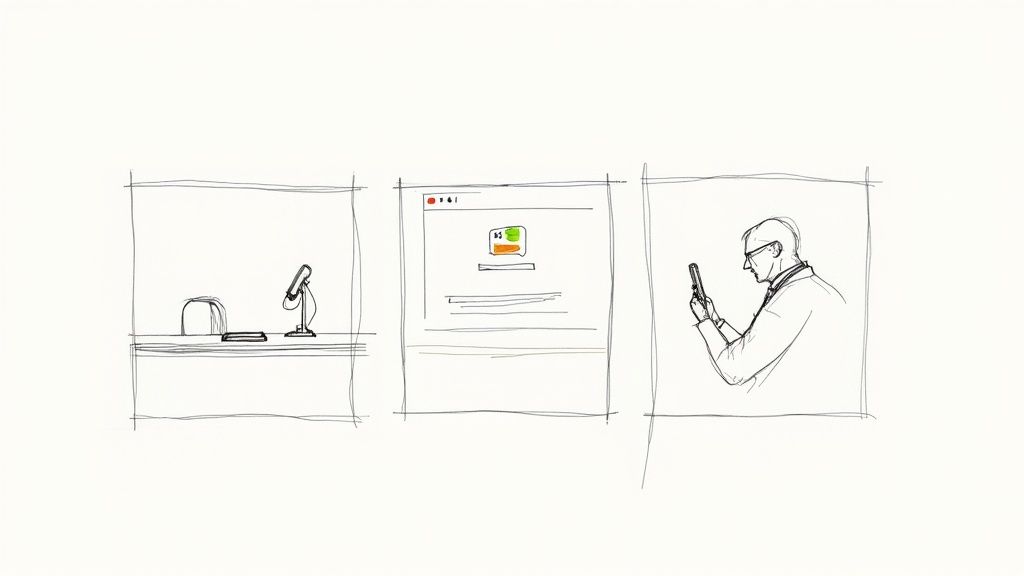
Driving Productivity Across Key Sectors
The technology is making its biggest waves in fields where documentation is a necessary evil—absolutely critical, but incredibly time-consuming. Let’s look at a few examples of how it’s being put to work.
- Healthcare: Instead of spending hours typing up notes after each visit, doctors and nurses can now dictate patient updates directly into their electronic health records (EHRs). This gives them more time to actually be with their patients and dramatically cuts down on administrative burnout.
- Legal: For legal professionals, speed and accuracy are everything. Speech to text tools can transcribe depositions, client meetings, and court hearings almost instantly. This creates a searchable, accurate record that helps speed up case preparation and review.
- Media and Content Creation: Journalists can get a full transcript of an interview just minutes after it's over. Podcasters and video creators can generate captions and show notes in a fraction of the time it used to take. There are even tools that can create an AI podcast summarizer to pull out the key takeaways automatically.
The common thread here is simple: a massive reduction in manual effort. By handing transcription over to AI, organizations aren't just saving time; they're also slashing the risk of human error in critical documents.
The Strategic Business Advantage
Bringing speech to text AI into your workflow is more than just a quick productivity fix. It’s a strategic decision that makes your content more accessible and unlocks hidden value from audio and video you already have.
Suddenly, years of recorded meetings, customer support calls, and training videos are no longer just sitting in a digital archive. They become searchable, analyzable data.
Think about it: a marketing team can now analyze hundreds of customer calls to spot common complaints or pinpoint what features people love. A university can instantly provide accurate lecture transcripts, giving students an incredible resource for studying and review. This is where the real competitive edge comes from—turning spoken words into structured, usable information.
Overcoming Common Transcription Hurdles
As impressive as speech to text AI is, it's not perfect. In the real world, it can get tripped up by heavy accents, niche jargon, or even just a noisy room. But don't worry—a few smart adjustments can make a world of difference in your results.
Let’s start with the basics: your microphone. This is your first line of defense against bad audio. Condenser and dynamic mics are built for different jobs, and picking the right one is a game-changer. For example, grabbing a simple cardioid headset mic can slash background noise by as much as 65% in a busy office, feeding the AI a much cleaner signal from the get-go.
Selecting Quality Hardware
When you're choosing a mic, think about its polar pattern (where it "listens"), frequency response, and where you'll place it. A speaker who moves around a lot might do well with a handheld mic, while a broadcast studio gets better results with a stationary boom mic. The most important thing? Test your setup in the actual environment before you hit record.
Now, let's talk vocabulary. Even the smartest AI needs a little help when you throw specialized terms at it. You can slash transcription errors by up to 73% by training a custom model on your industry's language. This is non-negotiable for fields like medicine or law, where a single wrong word can have serious consequences. Training is straightforward—you just feed the model audio samples with the correct transcriptions and let it learn.
"Accuracy hinges on context and preparation. A few well-chosen examples to train your model will go a surprisingly long way."
— AI Transcription Specialist
Building a Human Review Loop
No matter how good the AI gets, it's still going to miss things. Homophones (think "their" vs. "there"), slang, or people talking over each other can easily confuse an algorithm. That’s where a quick human check comes in. You don't have to review everything; having a person check just 10% of the transcribed audio can boost the final accuracy by a solid 15%. A great way to handle this is to break the audio into short clips and have team members do quick spot-checks through a shared platform.
Here are a few operational habits to get into:
- In time-sensitive situations, always double-check for misheard names and numbers.
- Flag any industry jargon the AI missed so you can add it in manually.
- Keep an ear out for background noise during recordings—what you hear, the AI hears too.
Tackling Language Complexity
What happens when people switch between languages or use different dialects in the same conversation? Basic models often stumble here. The solution is to use a language identifier that can detect the change and process each language segment with the right model. This simple step can dramatically improve clarity in multilingual recordings.
Finally, always run a dress rehearsal. Record a mock meeting or a test interview and push it through your entire workflow, from recording to final transcript. Compare what the AI produced with what was actually said. This is how you find the weak spots.
By pairing good hardware with custom-trained models and a smart human-in-the-loop process, you can turn messy, jargon-filled audio into clean, accurate text. It all comes down to practical preparation. Set realistic expectations, measure your results, and keep refining your process.
Practical Examples of AI Transcription in Action
It’s one thing to talk about how the technology works, but it's another to see it in the wild. Speech to text AI is already making a huge difference in the real world, far beyond just being a neat gadget. It's helping people learn, improving how companies listen to their customers, and changing the game for content creators.
The core idea is simple but powerful: turning spoken words—which are hard to search and analyze—into text that is structured, findable, and full of potential. Let's look at a few places where this is already happening.
Making Higher Education More Accessible
Walk into any modern university lecture hall, and you’ll find a diverse group of students. Some might have hearing difficulties, while others might be learning in a second language. This is where AI transcription really shines.
By automatically transcribing lectures, universities can give every student an instant, accurate text version of the class. This means they can go back and review a tricky concept, search for a specific term the professor mentioned, or simply follow along without missing a beat. It creates a level playing field and makes learning more inclusive for everyone.
Finding Customer Gold in Call Centers
Call centers are sitting on a mountain of valuable information. Every day, they handle thousands of customer calls, but most of that insight gets lost because who has time to listen to it all? This is where speech to text AI steps in and completely changes the equation.
When you transcribe every single call, you can finally start to understand what your customers are really saying at scale.
- Spotting Unhappy Customers: The AI can pick up on tone and keywords to flag calls where a customer is frustrated or angry, letting a manager step in before things escalate.
- Catching Key Trends: Is everyone suddenly mentioning a bug in your new software update? Or asking for a specific feature? The system can spot these patterns automatically.
- Keeping Everyone Compliant: In regulated industries, AI transcription can verify that agents are sticking to the script and meeting legal requirements, which drastically reduces risk.
This turns a call center from a simple support function into a vital source of business intelligence. It's no wonder the global AI transcription market, currently valued at USD 4.5 billion, is expected to skyrocket to USD 19.2 billion by 2034.
Supercharging Media Production
If you've ever produced a podcast or edited a video, you know the pain of "scrubbing" through hours of audio just to find one perfect quote. It’s tedious, frustrating, and a massive time-sink. AI transcription fixes this.
The accuracy and speed required for AI for medical transcription is a testament to the technology's power. While the stakes are different in media, the fundamental benefit of making audio searchable is the same.
Creators can now just upload their audio or video file and get a time-stamped transcript back in minutes. Instead of listening for hours, they can just use Ctrl+F to find a keyword, see exactly where it was said, and jump straight to that moment in the editor. This makes creating captions, writing show notes, and pulling clips for social media almost effortless. The same logic helps teams be more productive by taking minutes at meetings automatically, freeing everyone up to focus on the conversation itself.
How to Get the Best Results from Your Speech to Text AI
Just having a speech to text AI isn't enough; you have to know how to use it well. Think of it less like flipping a switch and more like developing a smart workflow. Getting clean, reliable transcripts every single time comes down to a few key habits, from picking the right tool to how you handle your audio and review the final text.
It's really a partnership between you and the AI. Your job is to feed it the best possible input—clear audio without a lot of background chatter. The AI's job is to do the heavy lifting. When you both do your part, the results are fantastic.
A Practical Checklist for Accurate Transcripts
To really get your money's worth, a structured approach makes all the difference. A few simple steps can dramatically boost your accuracy and efficiency, turning a decent tool into one you can't live without.
Pick the Right Tool for the Job: Not all transcription services are built the same. You need a platform that delivers high accuracy for your specific industry, accents, and dialects. Make sure it also supports your file formats and fits neatly into how you already work.
Audio Quality is Everything: The old saying "garbage in, garbage out" has never been more true. A good microphone and a quiet room will do more for your accuracy than anything else. Speak clearly and at a natural pace. This single step is the most effective way to improve the AI's performance.
Always Have a Review Step: Even the best AI can stumble over company-specific jargon, unique names, or when people talk over each other. A quick human review—sometimes called a "human-in-the-loop" process—is essential for catching those small errors. For a deeper dive, check out our guide on how to expertly convert audio to text.
The goal isn't just to use the tool, but to master it. The best results always come from blending AI's incredible speed with a touch of human oversight. That's the recipe for a system that's both fast and exceptionally accurate.
Finally, don't just set it and forget it. Keep refining your process. Pay attention to the types of errors that pop up and look for ways to improve your recording setup or review checklist. When you treat speech to text AI as a dynamic tool that learns from you, you unlock its true power.
Ready to turn your audio and video into accurate, searchable text in seconds? Whisper AI offers state-of-the-art transcription and summarization across 92+ languages. Join 50,000+ users and try it today.
